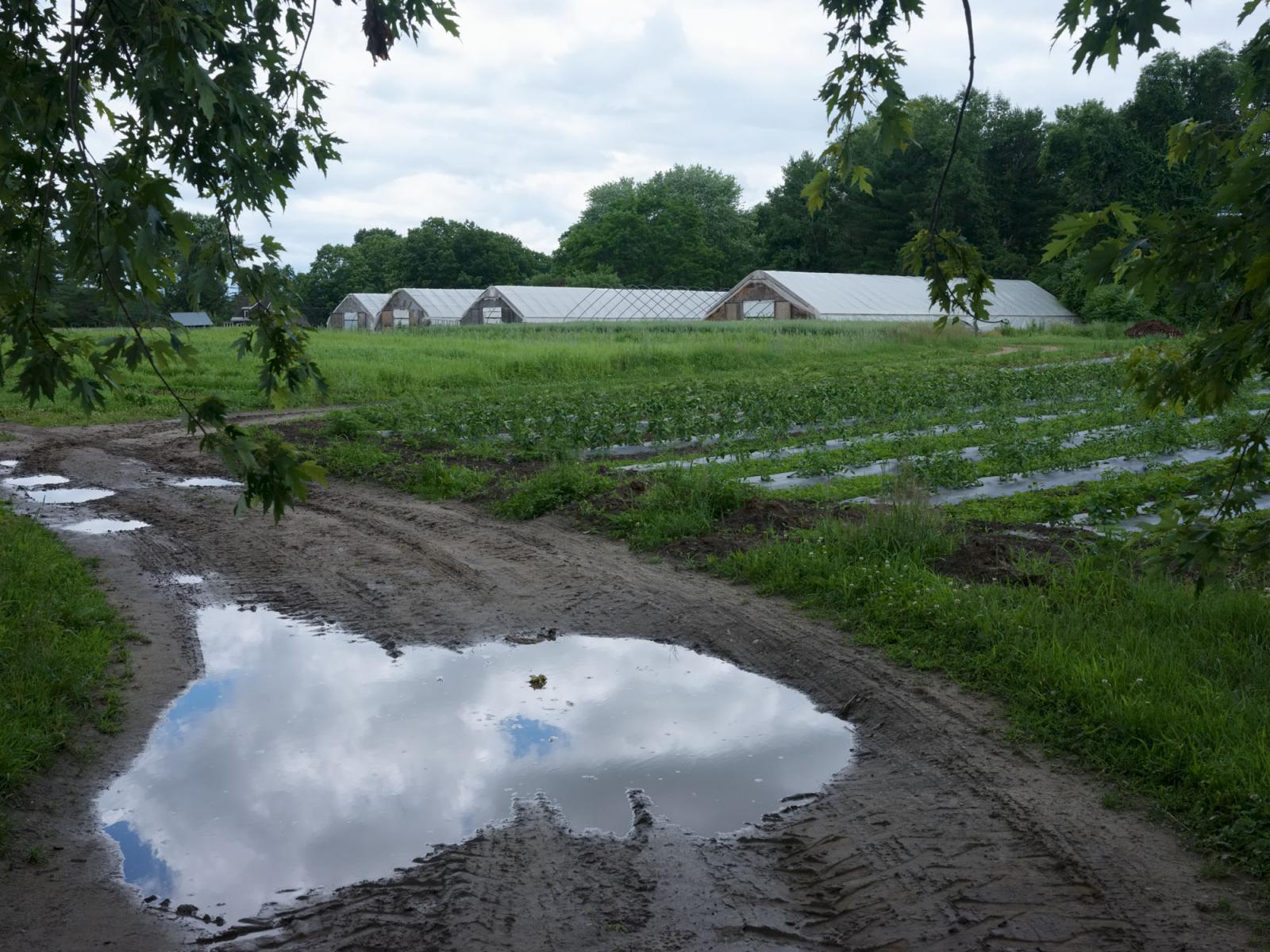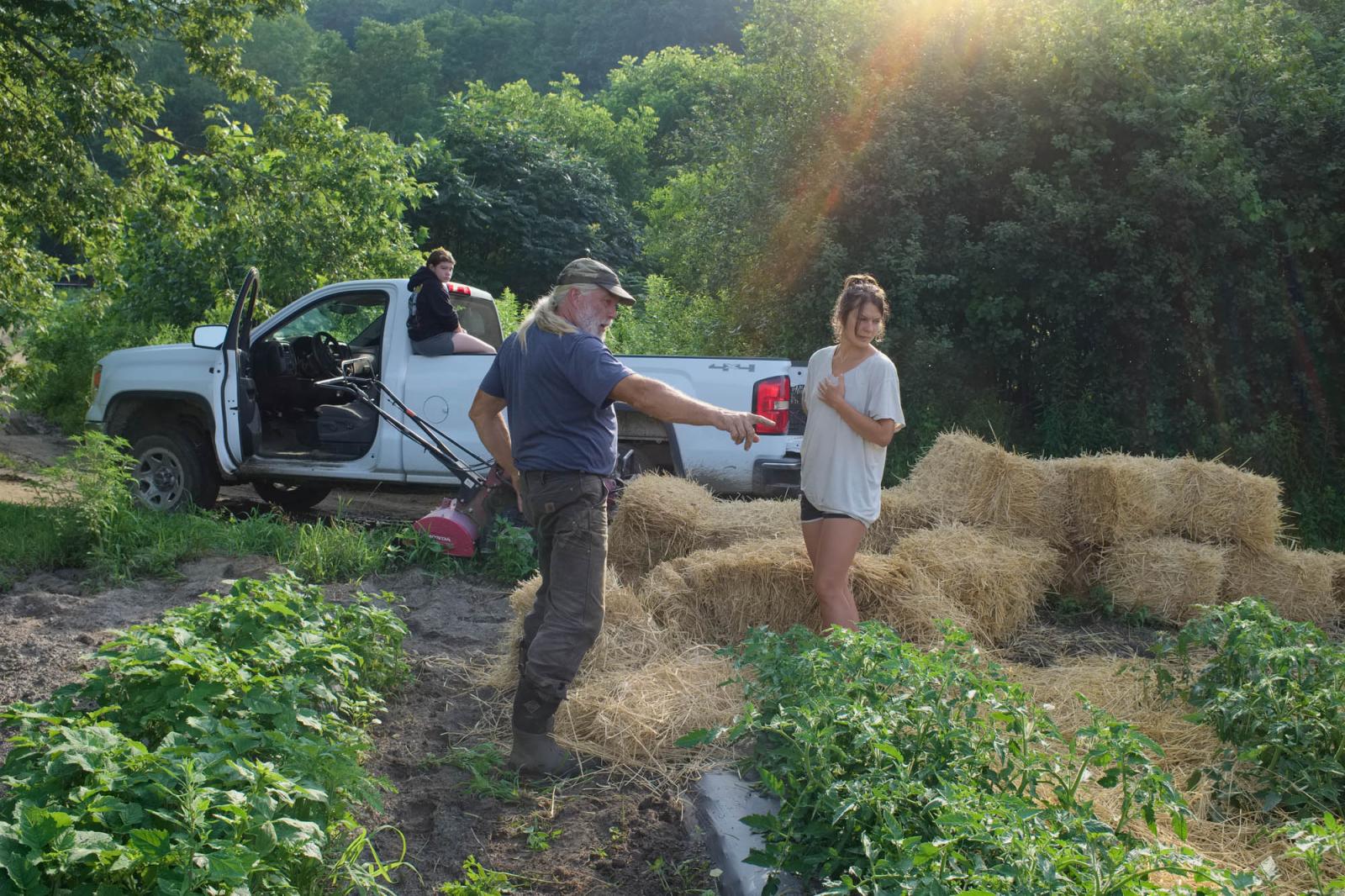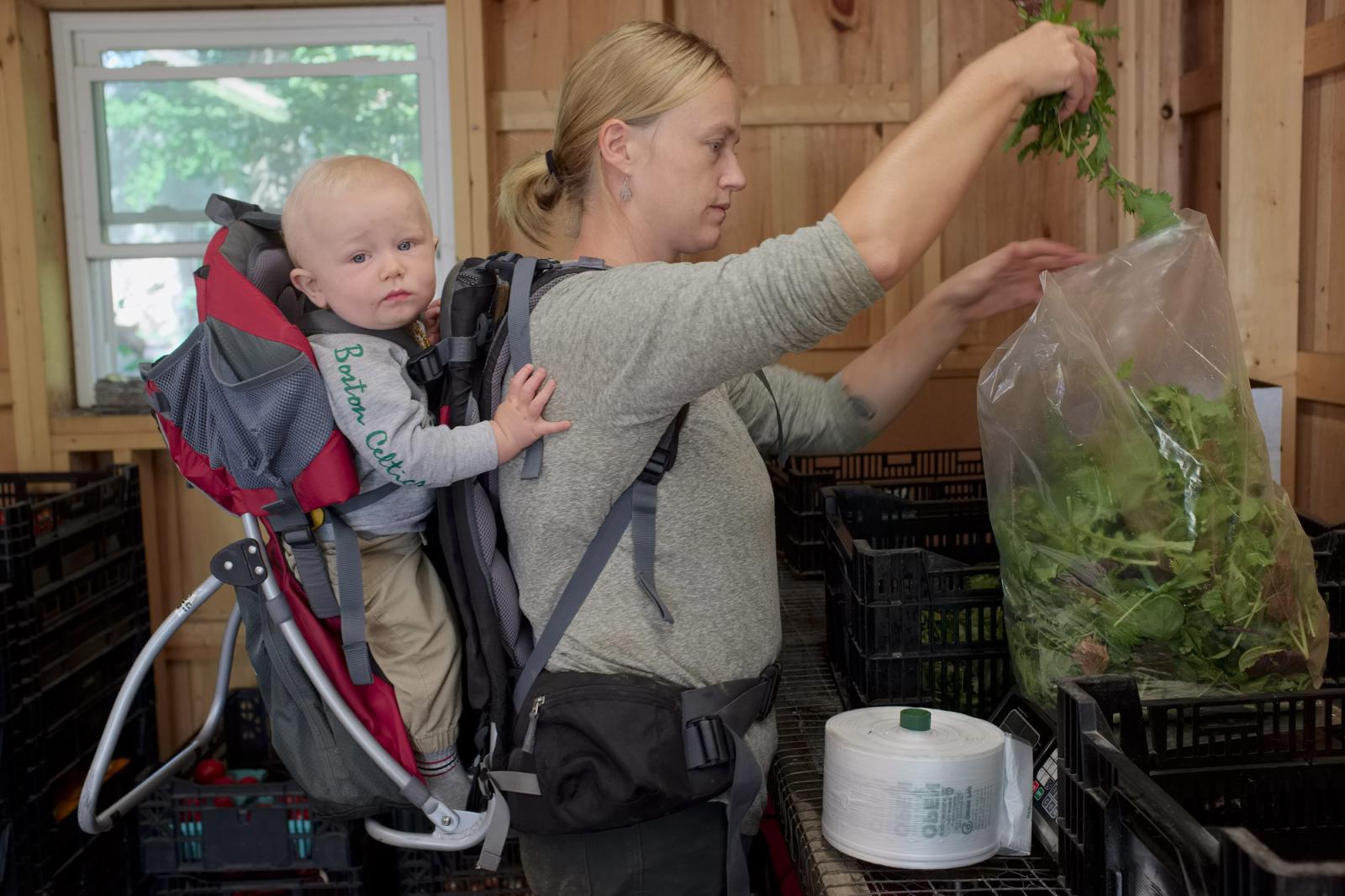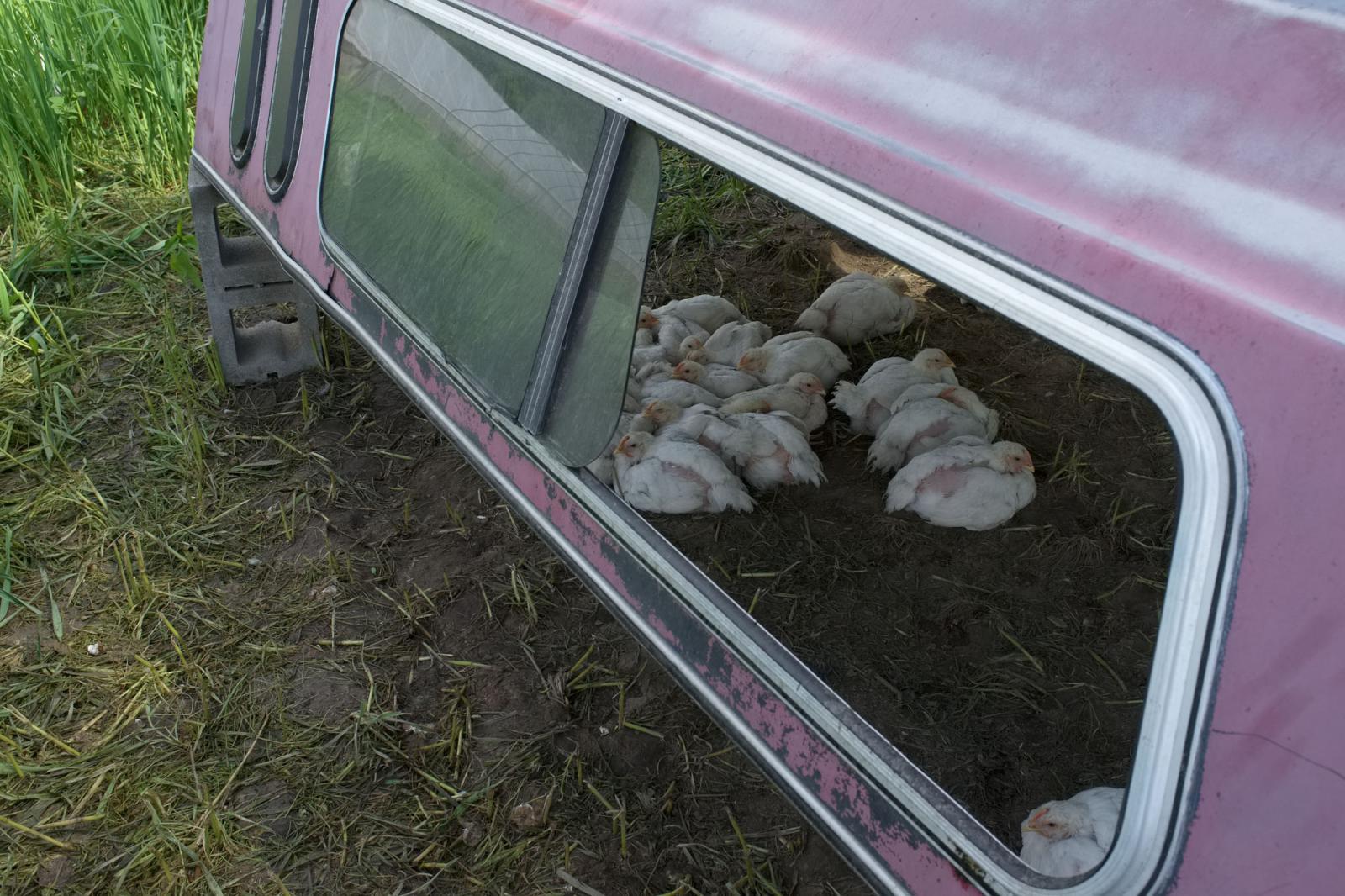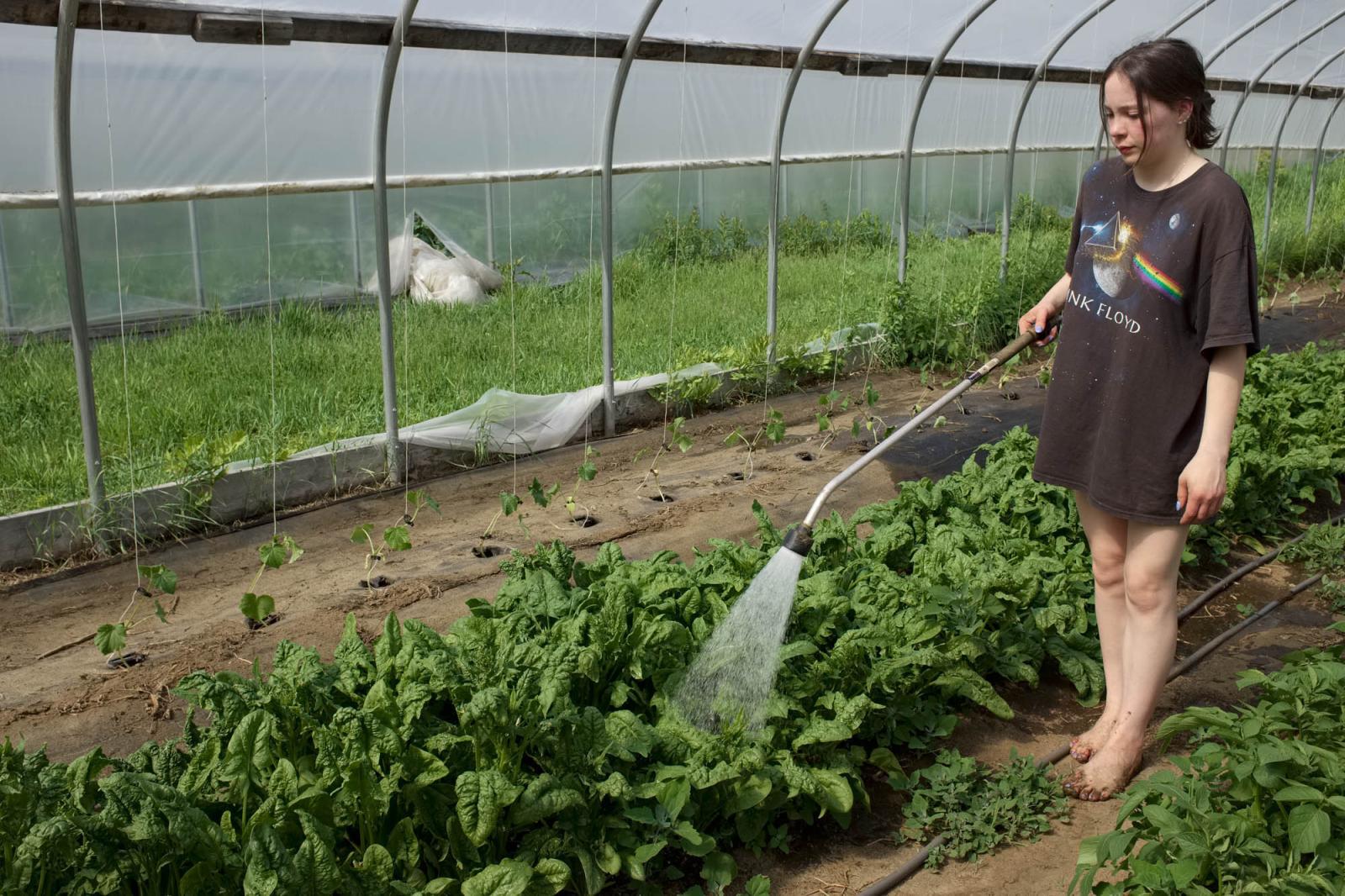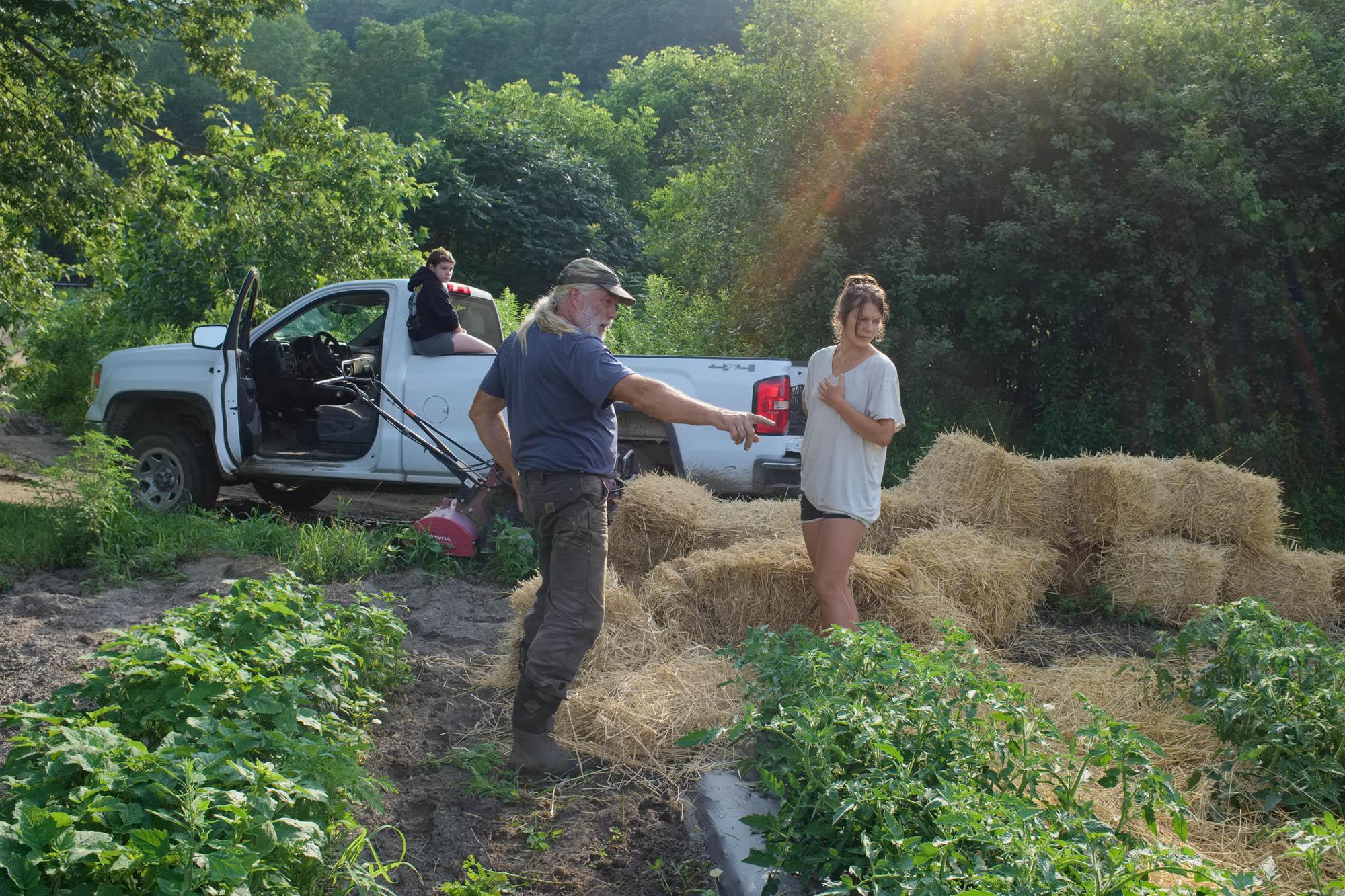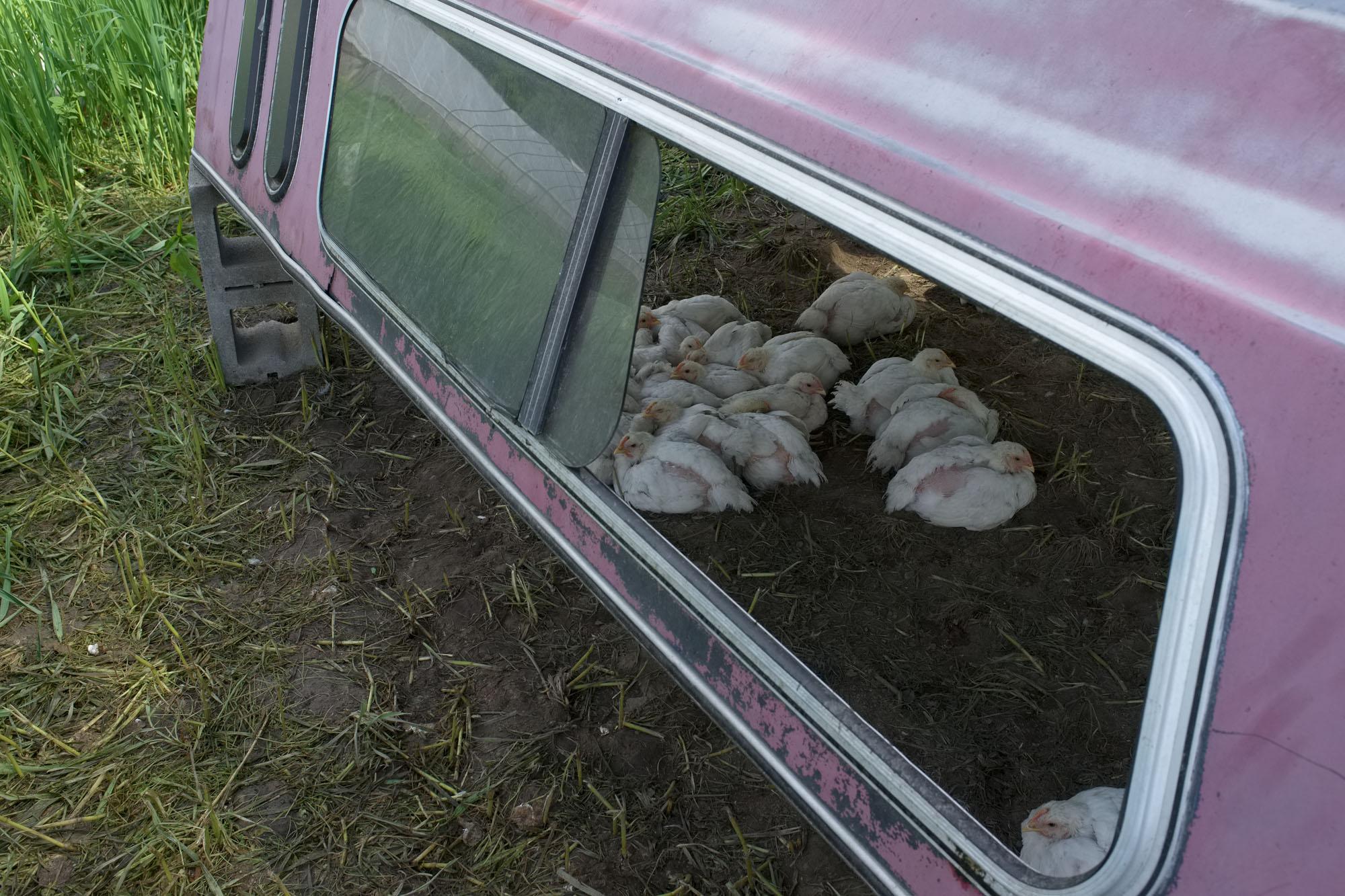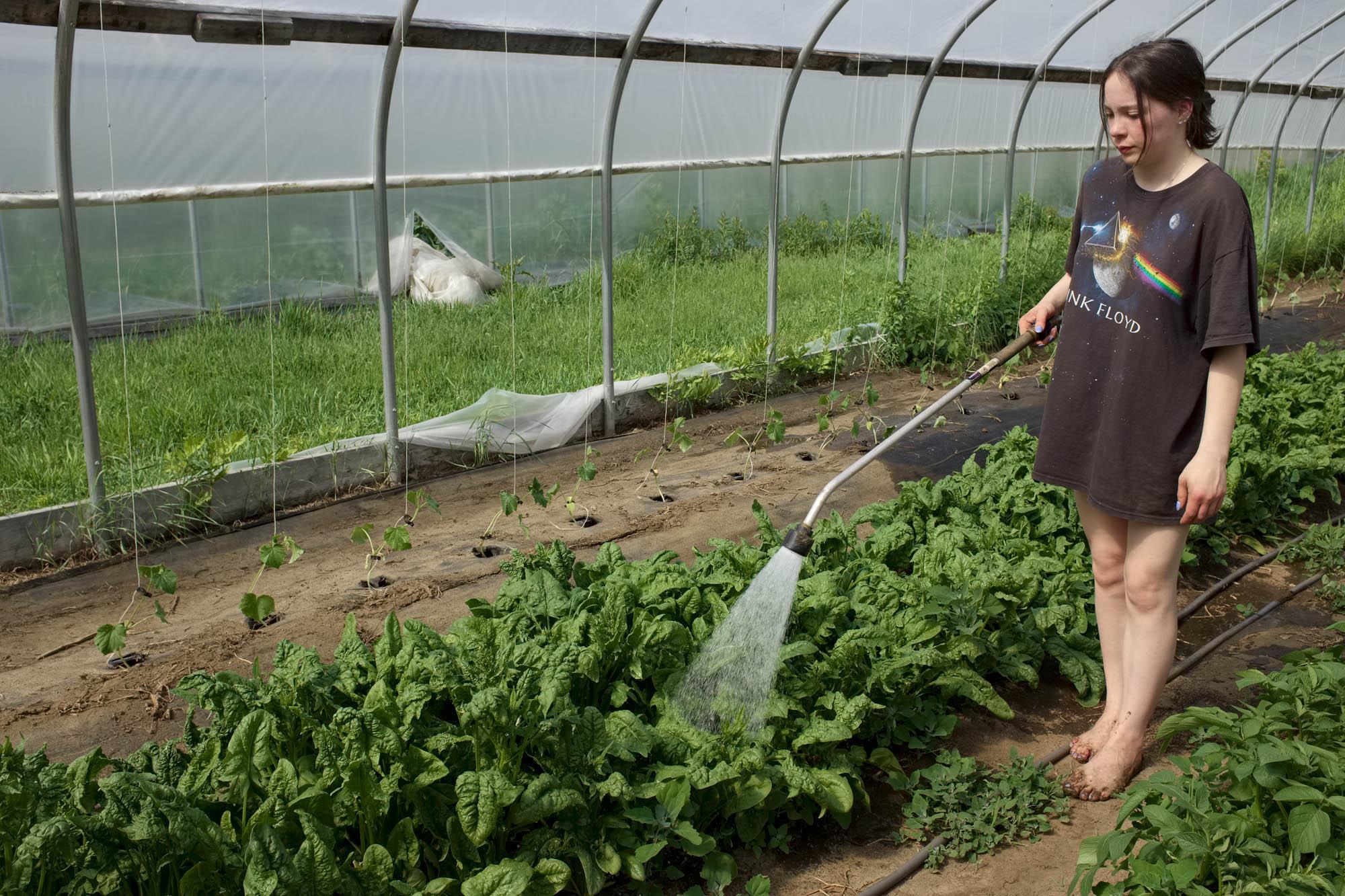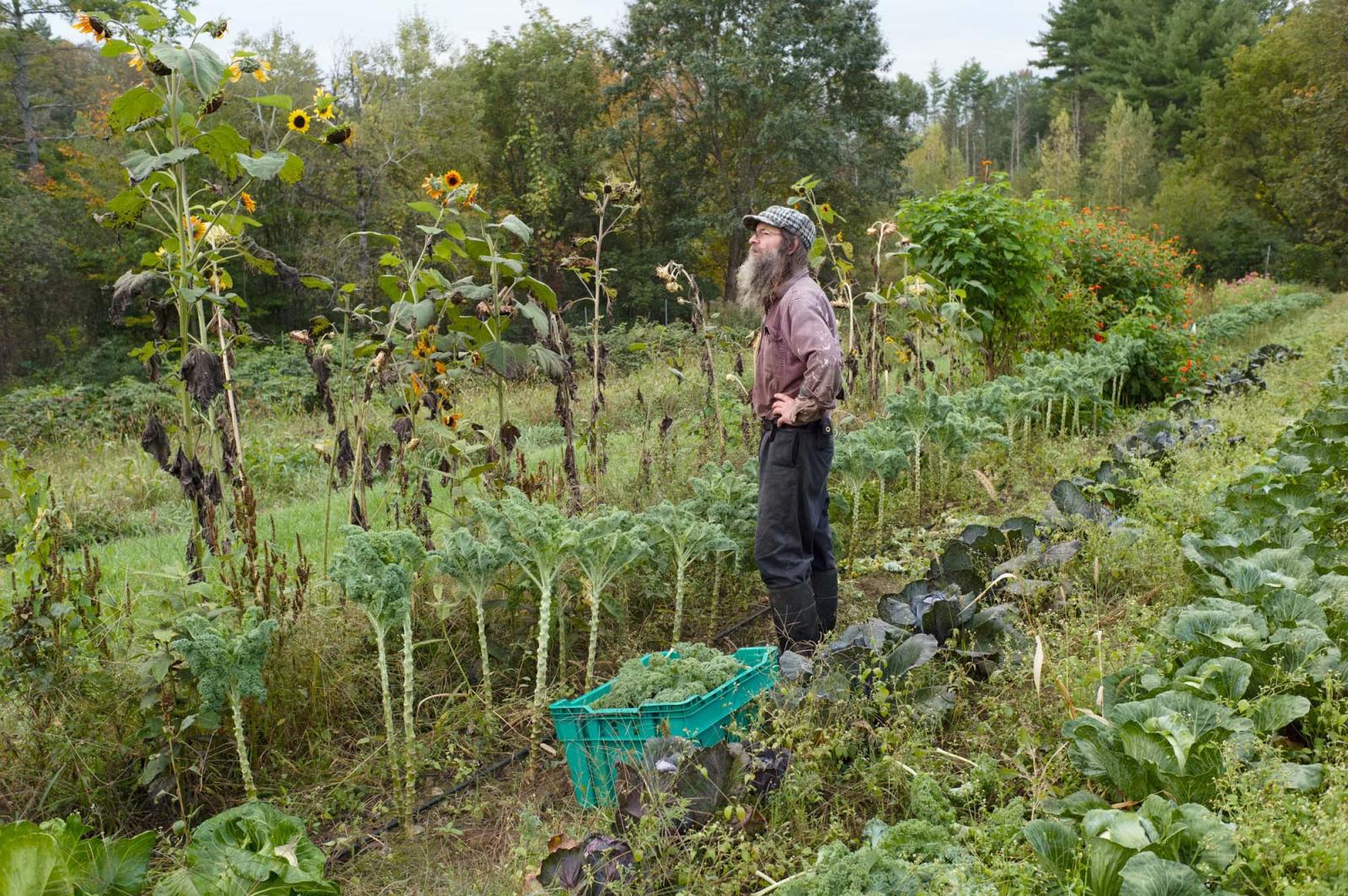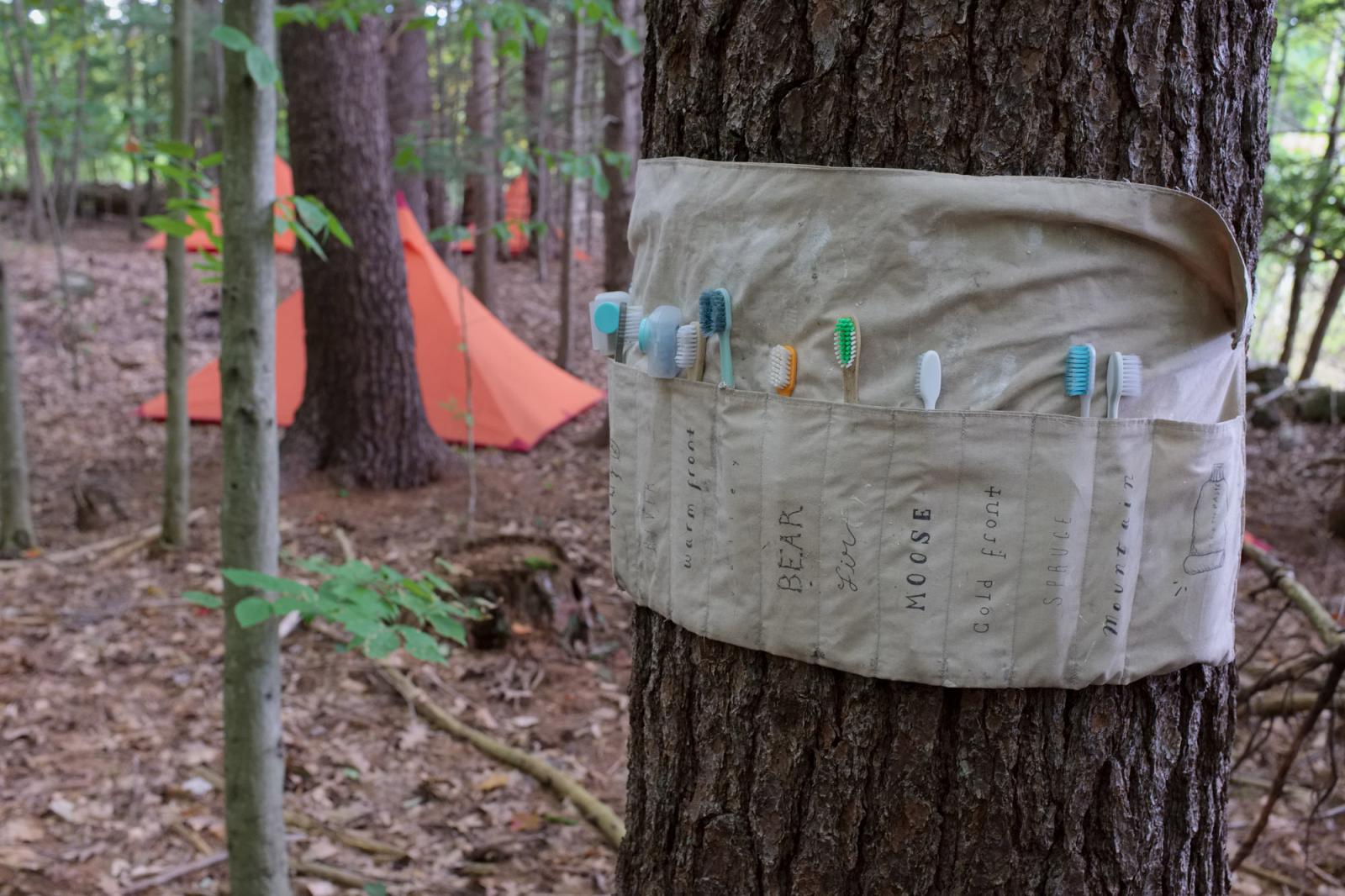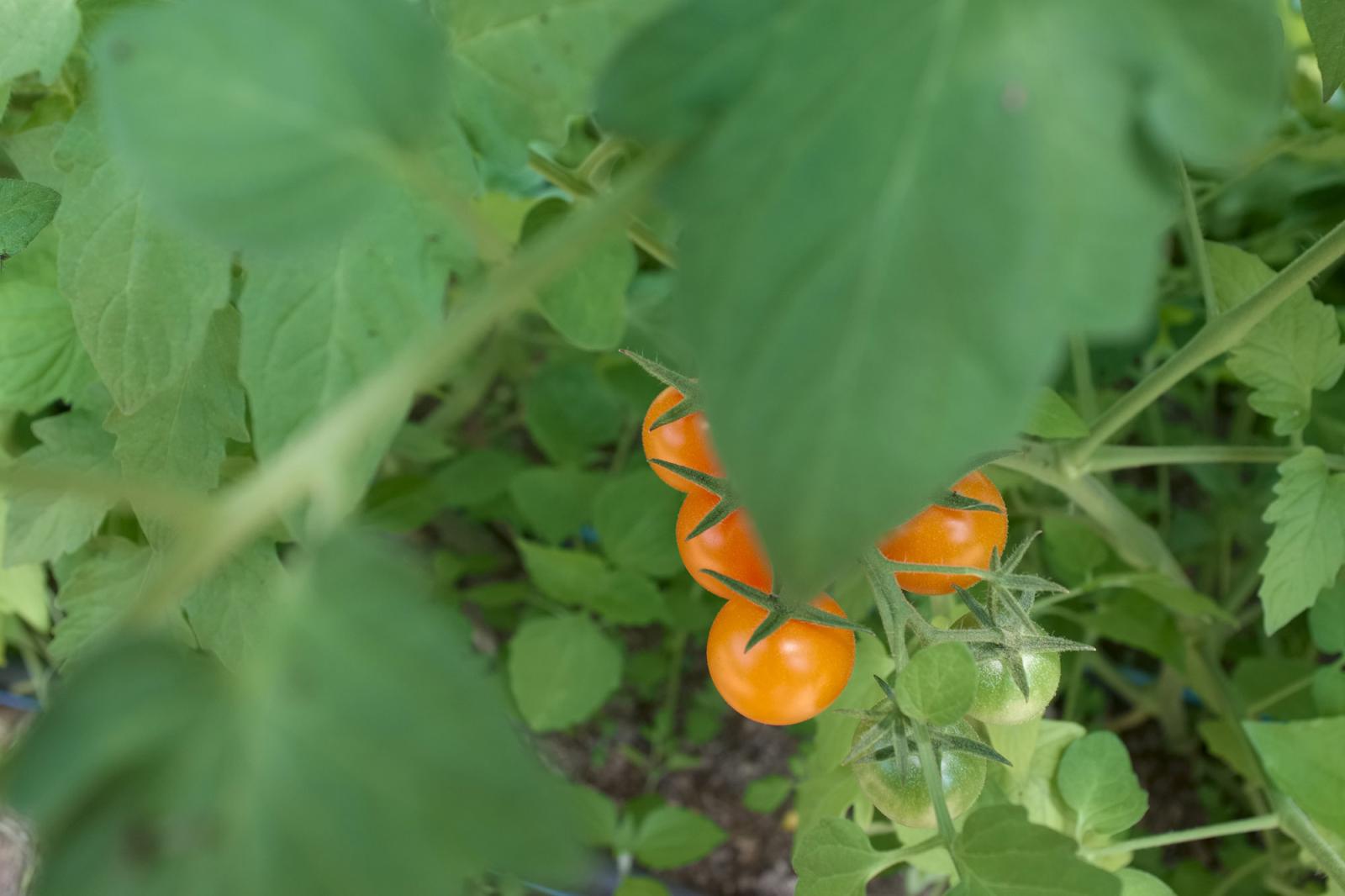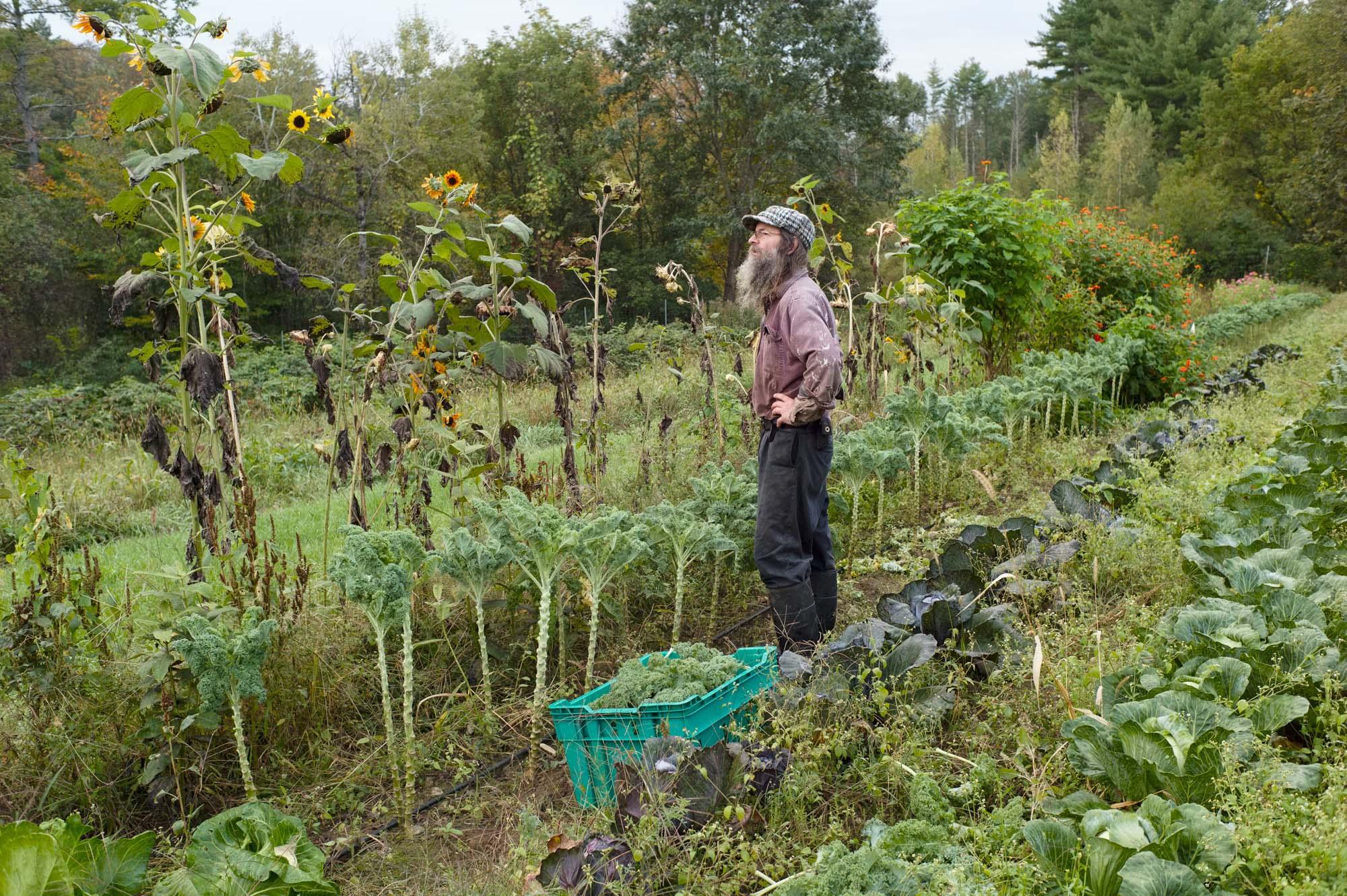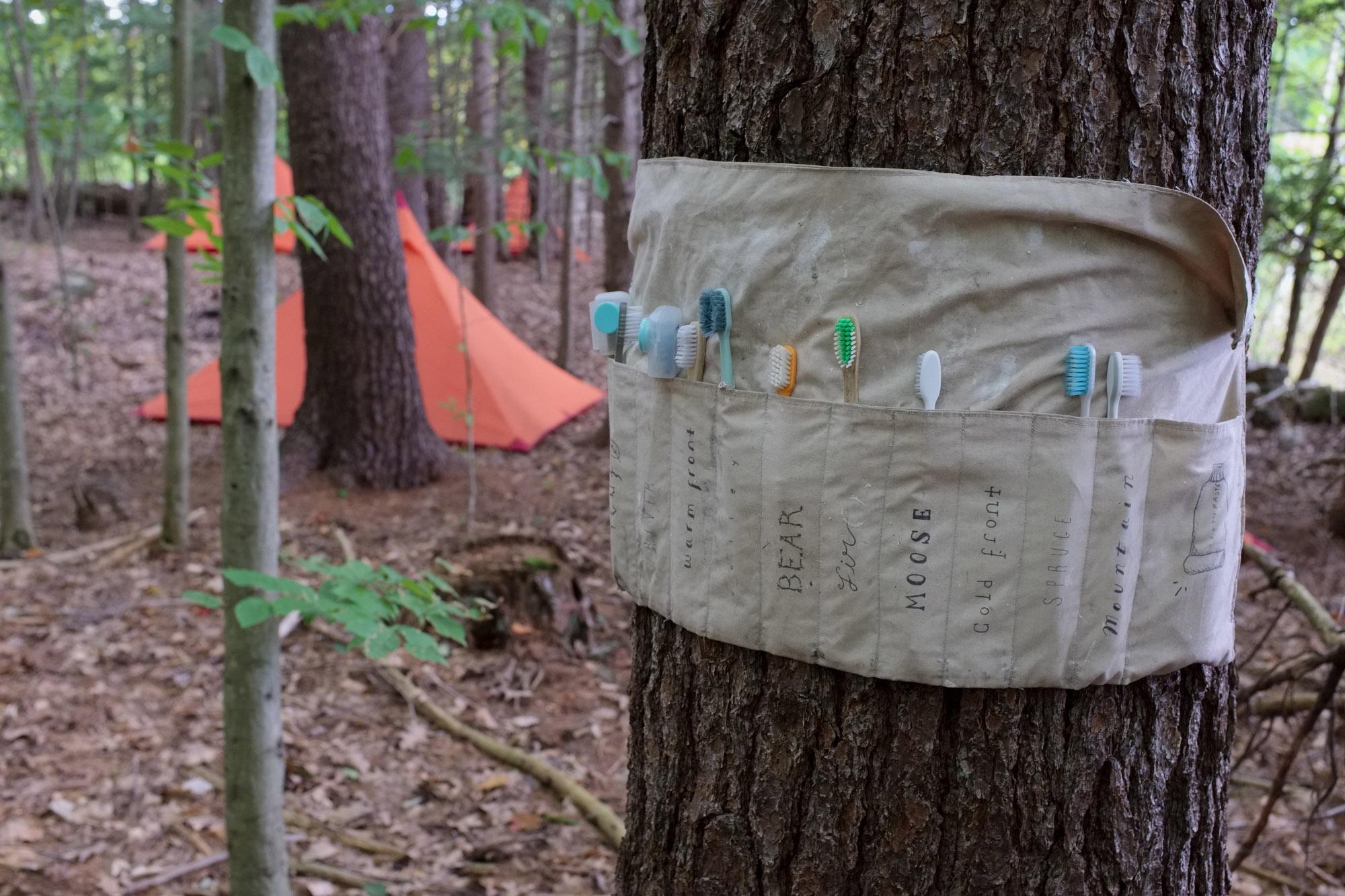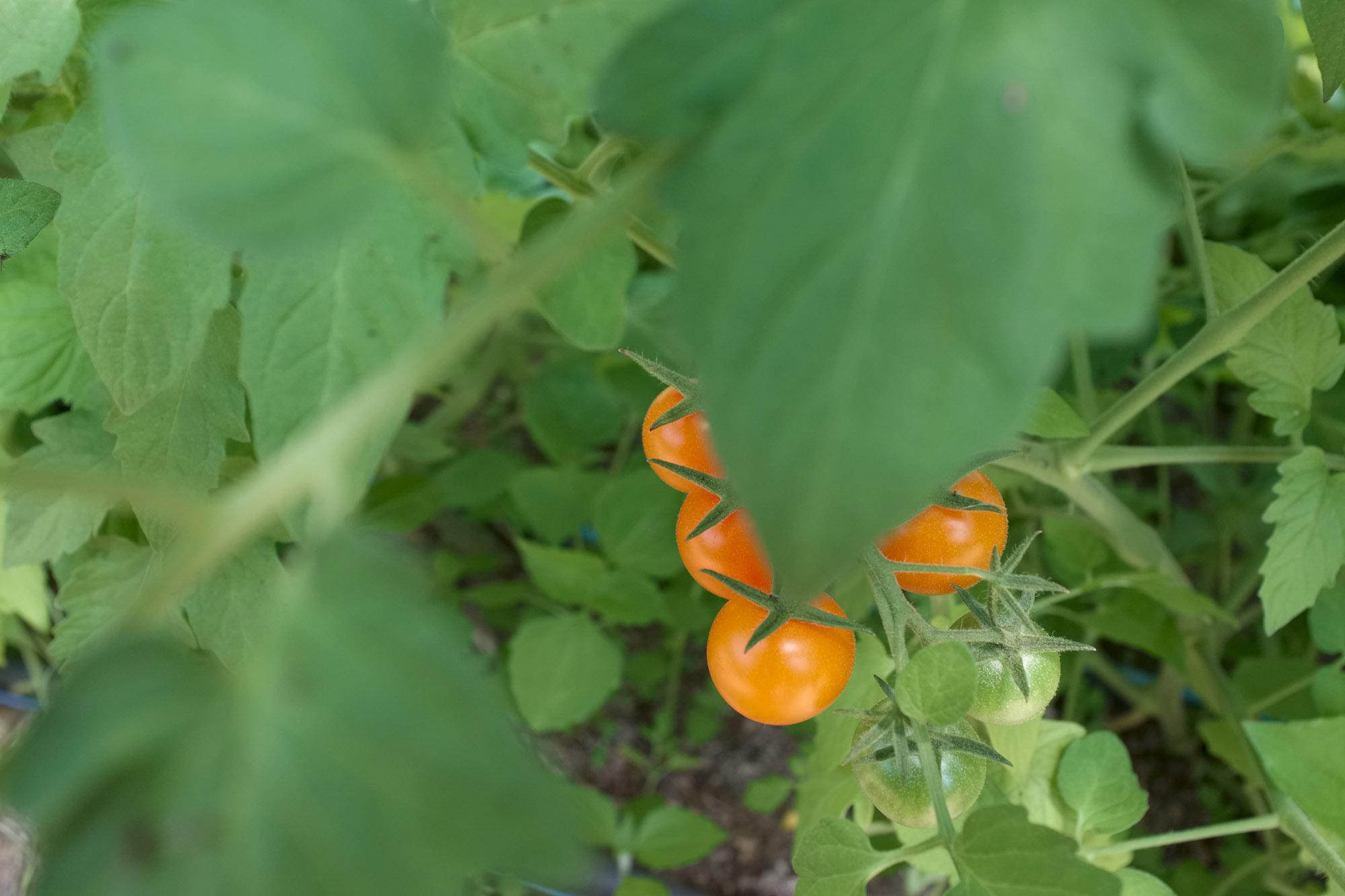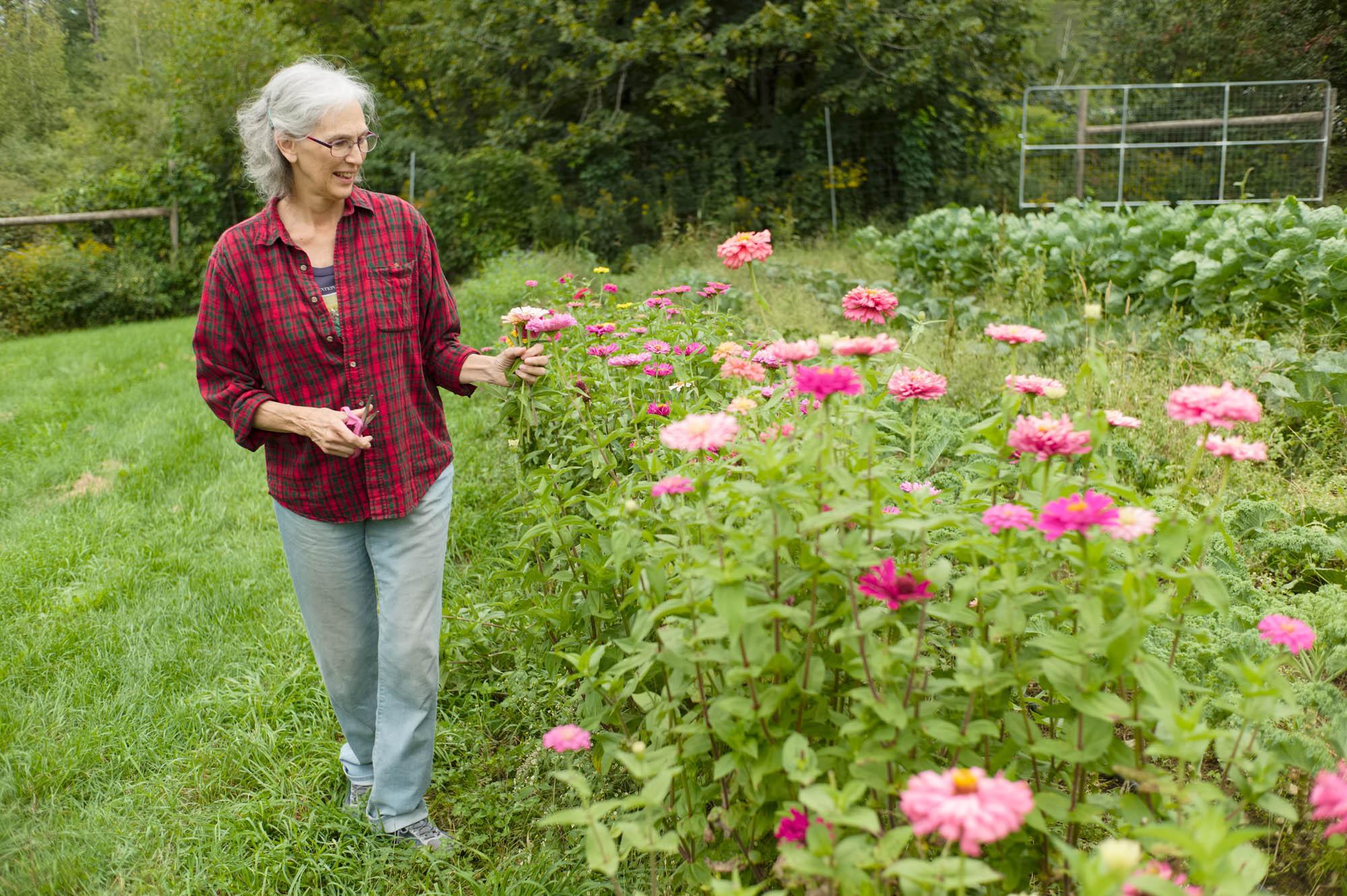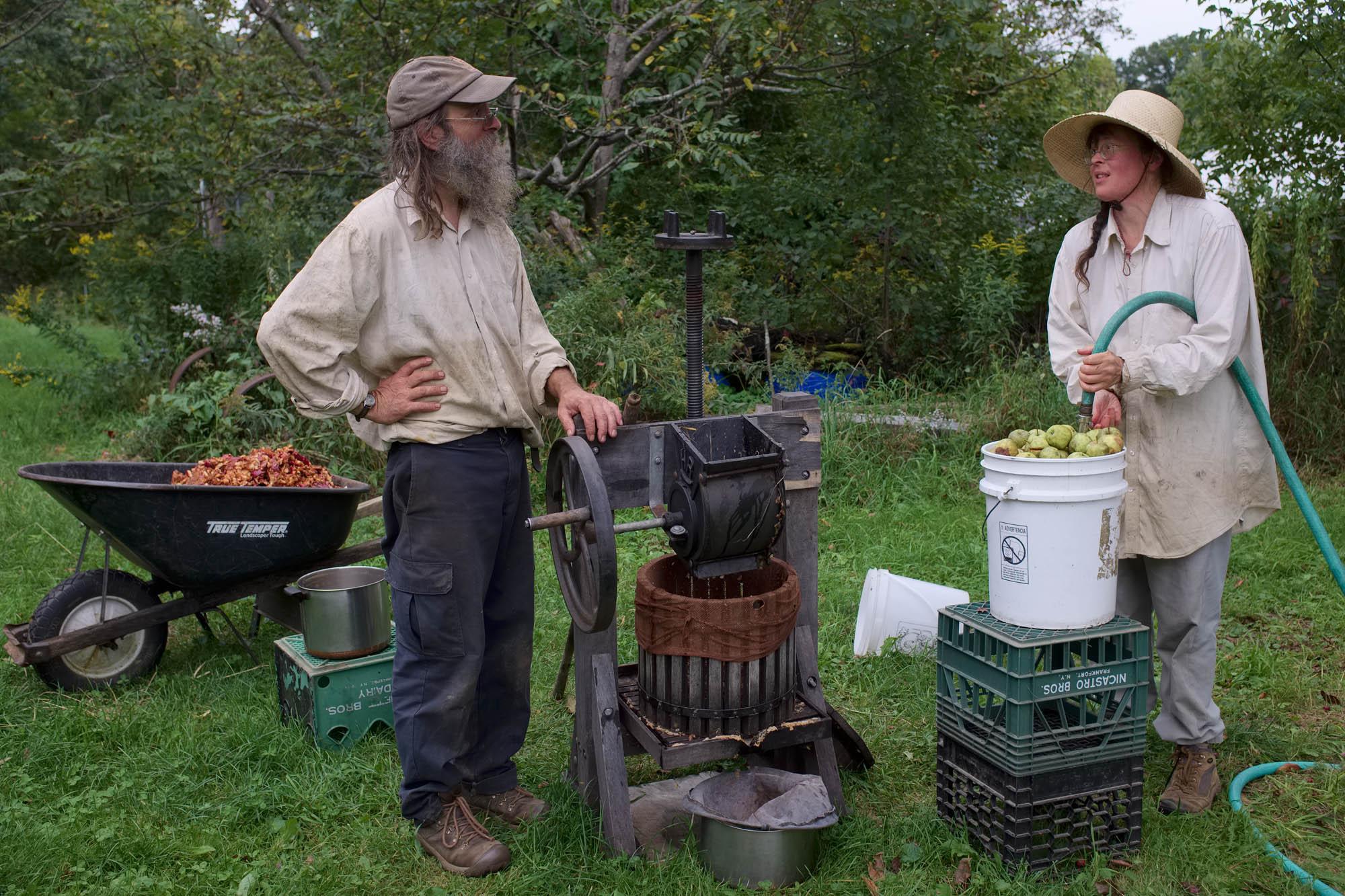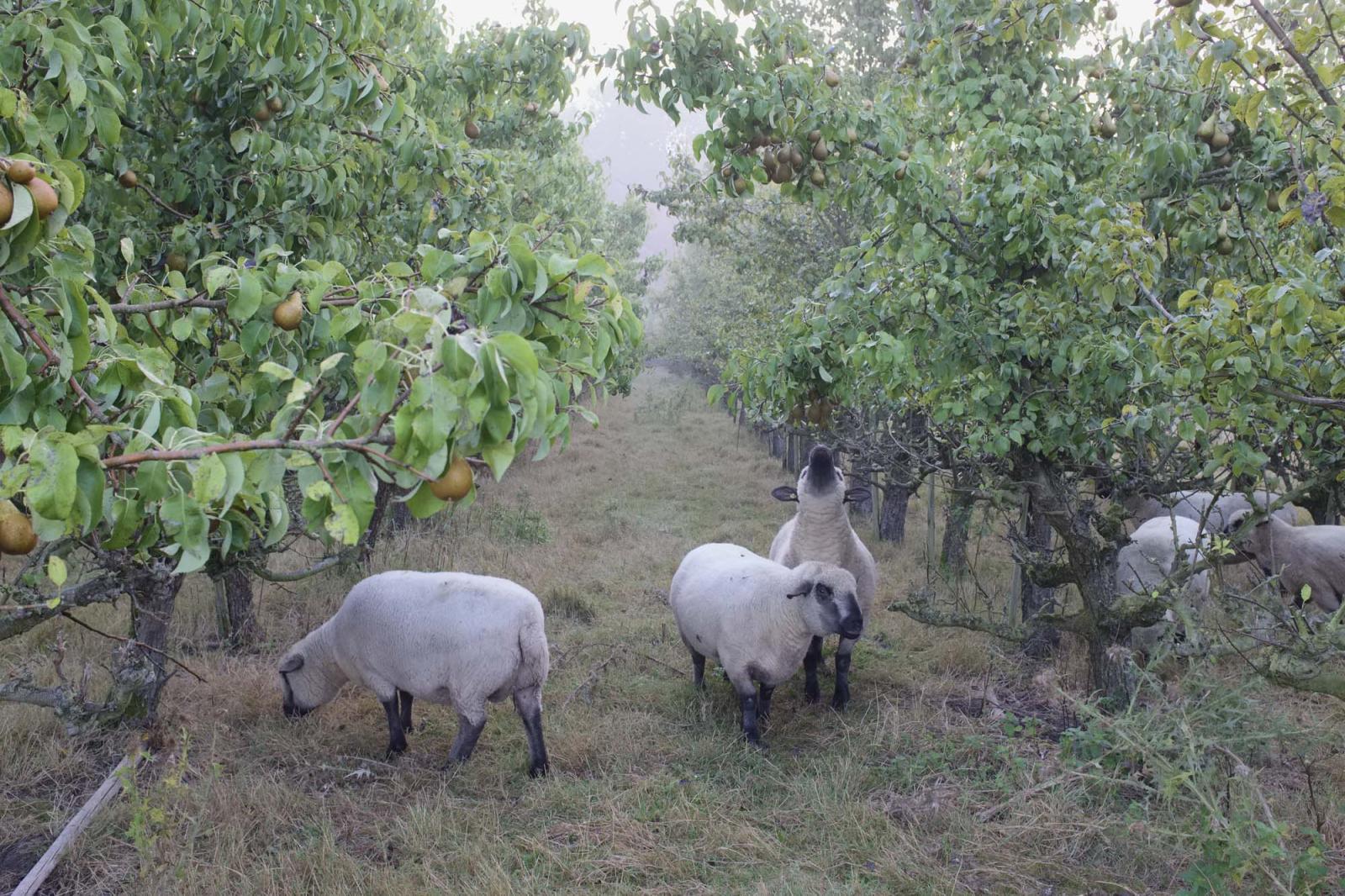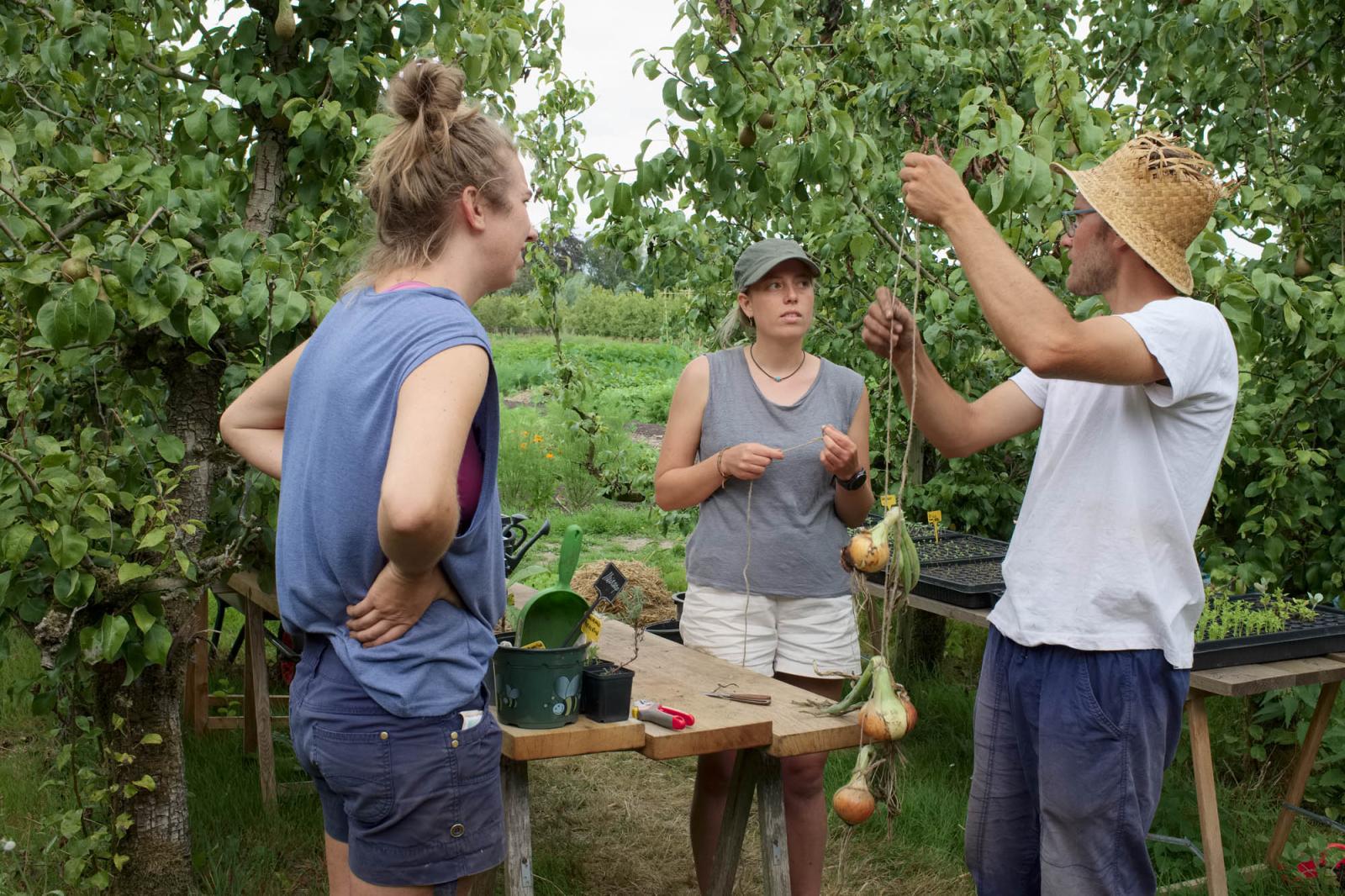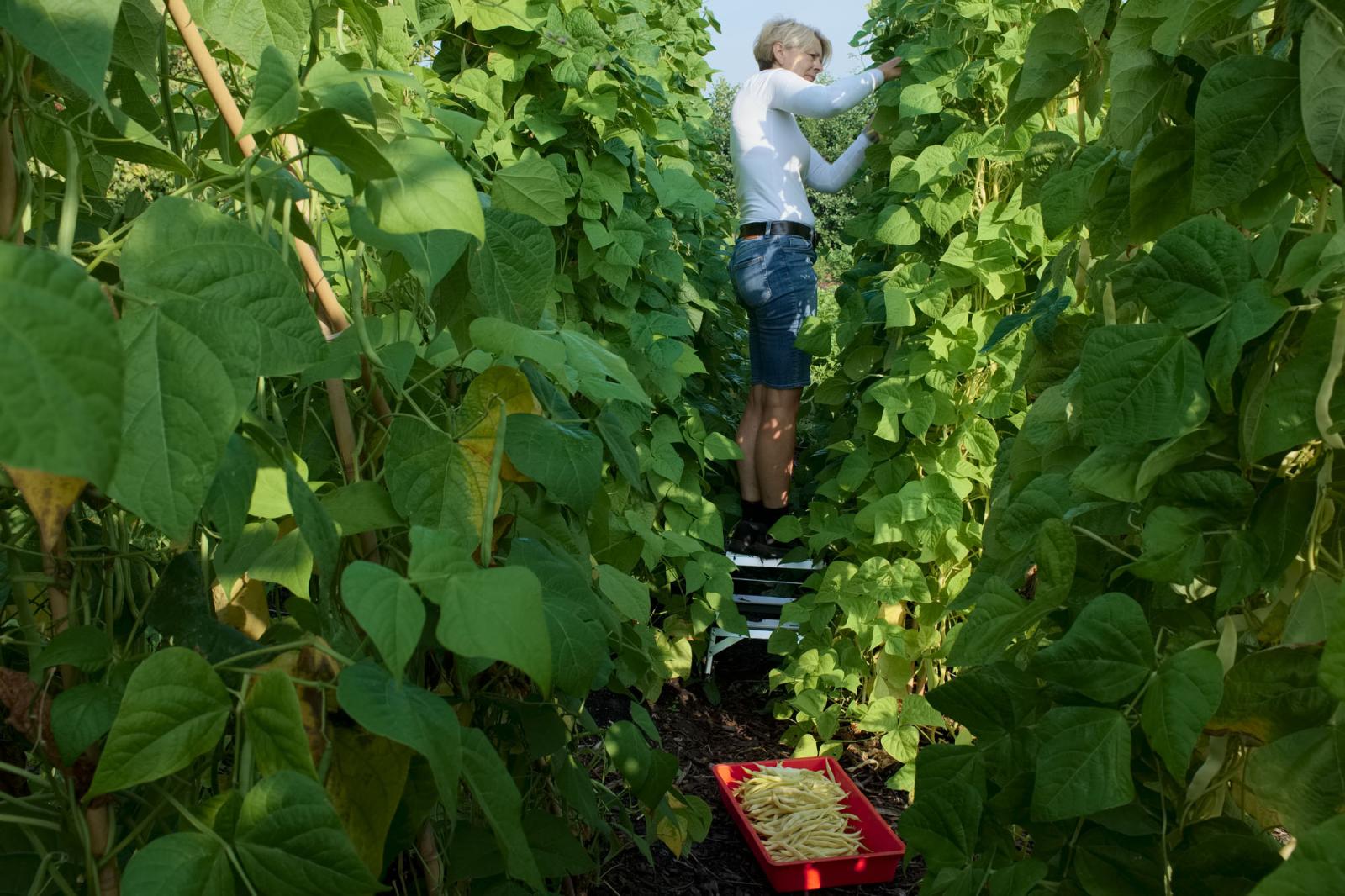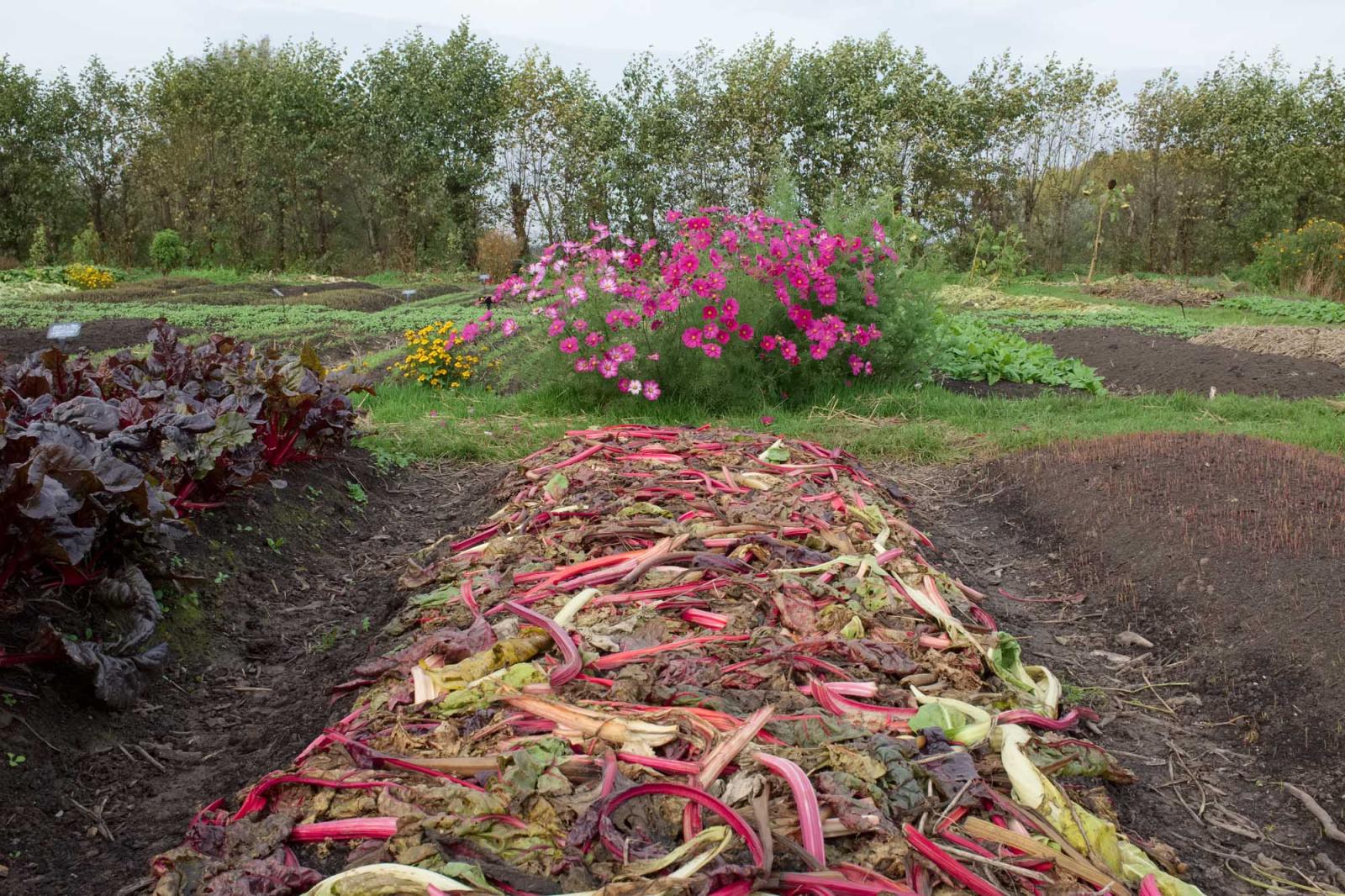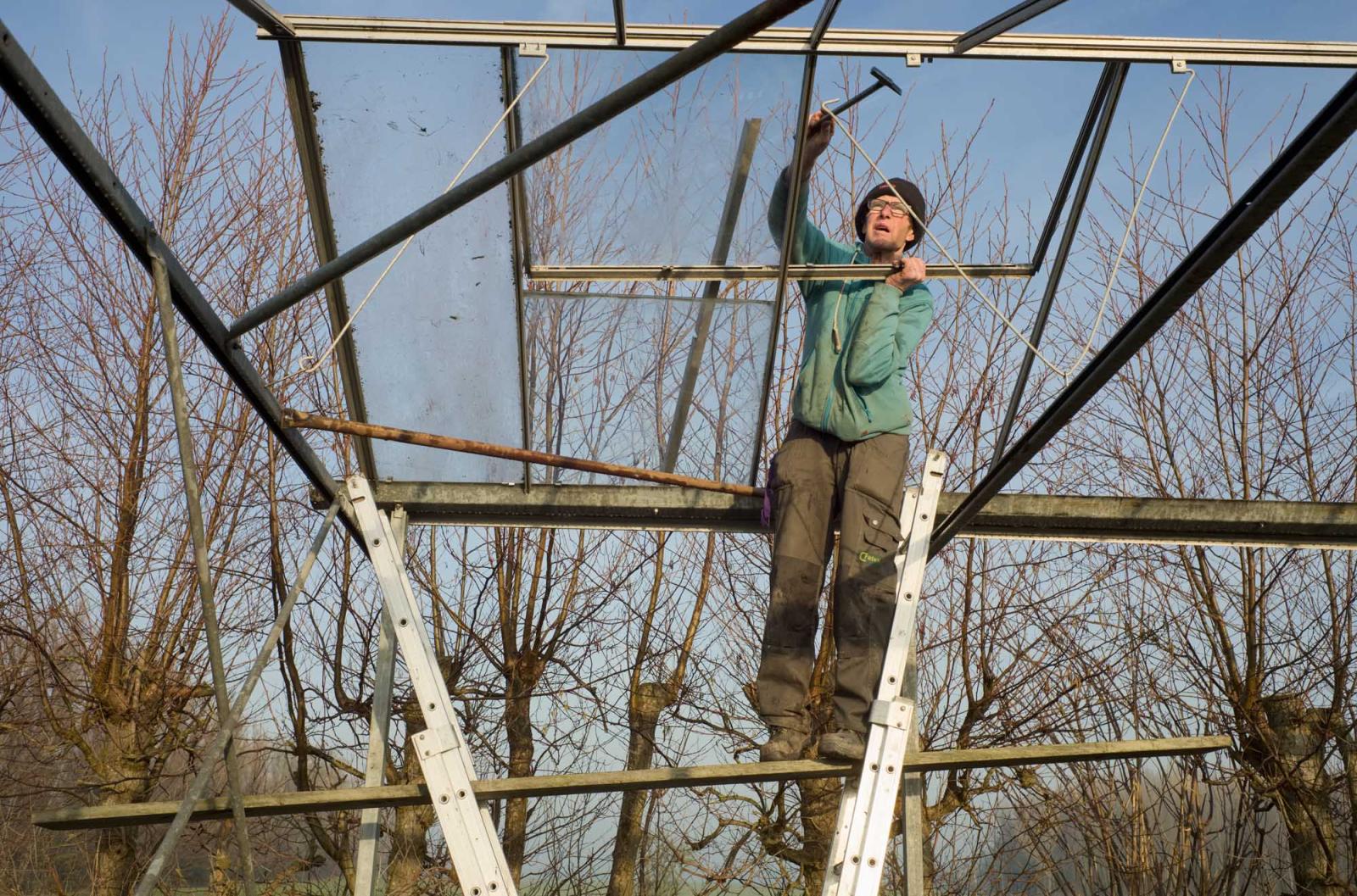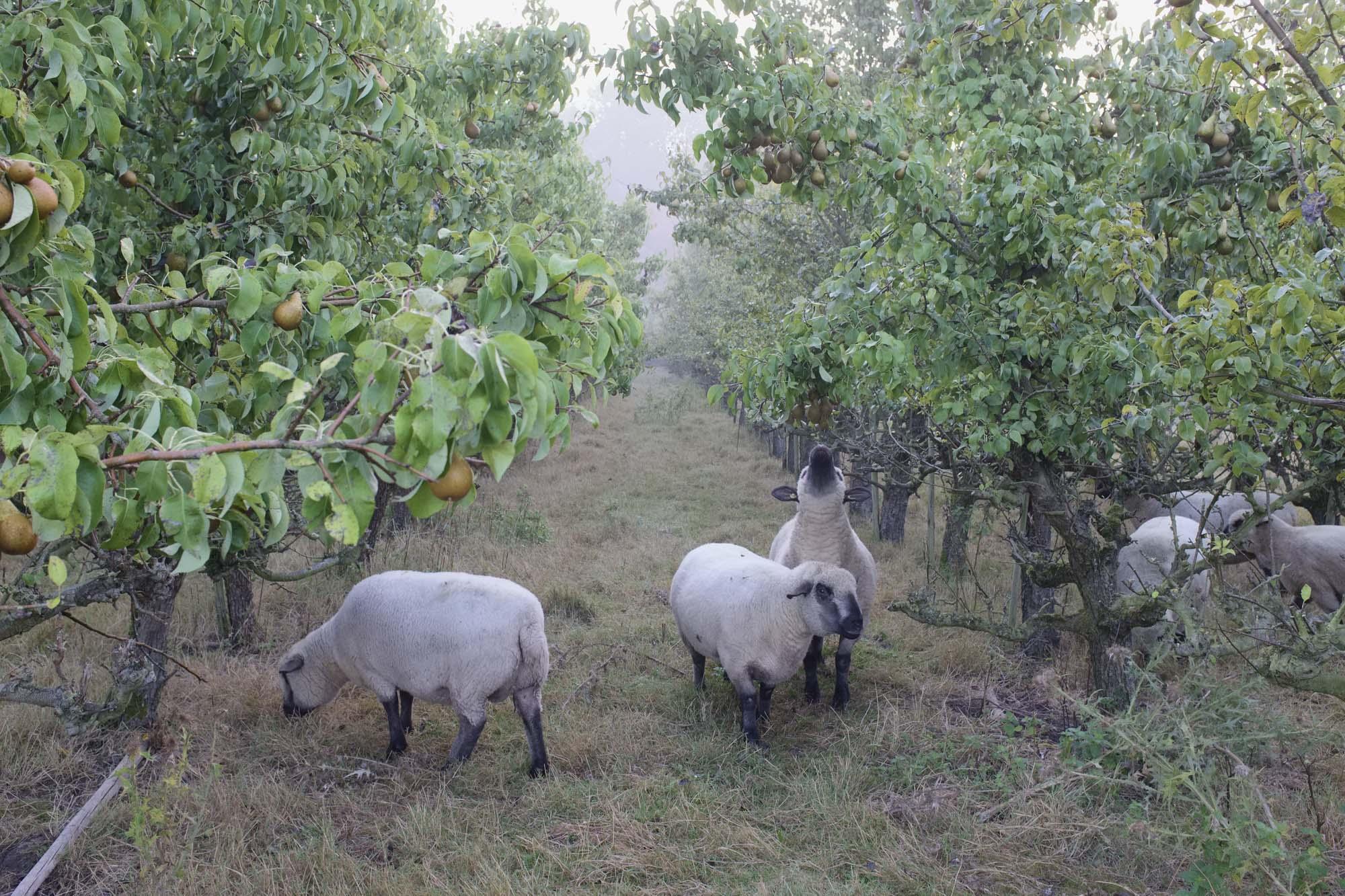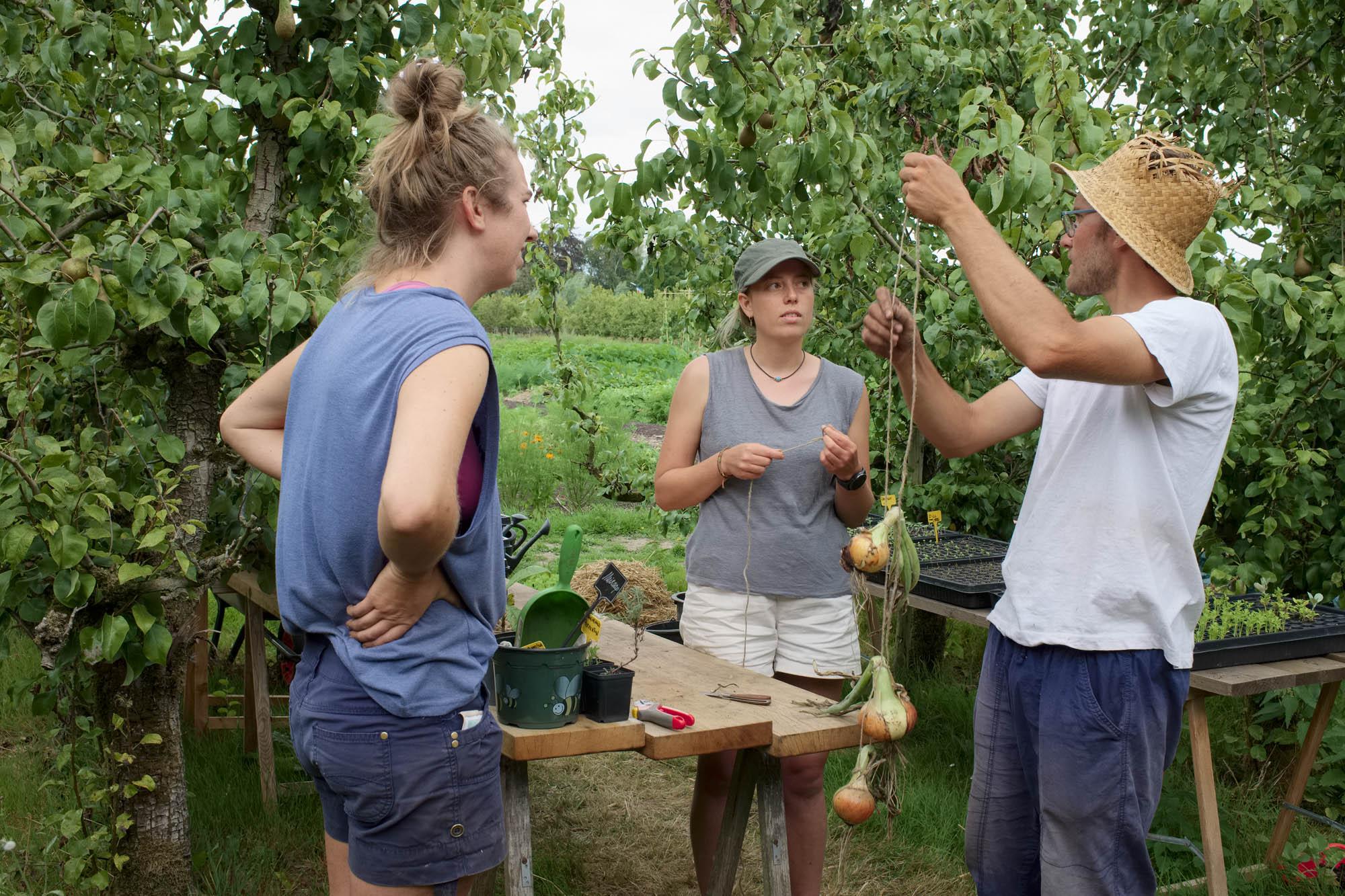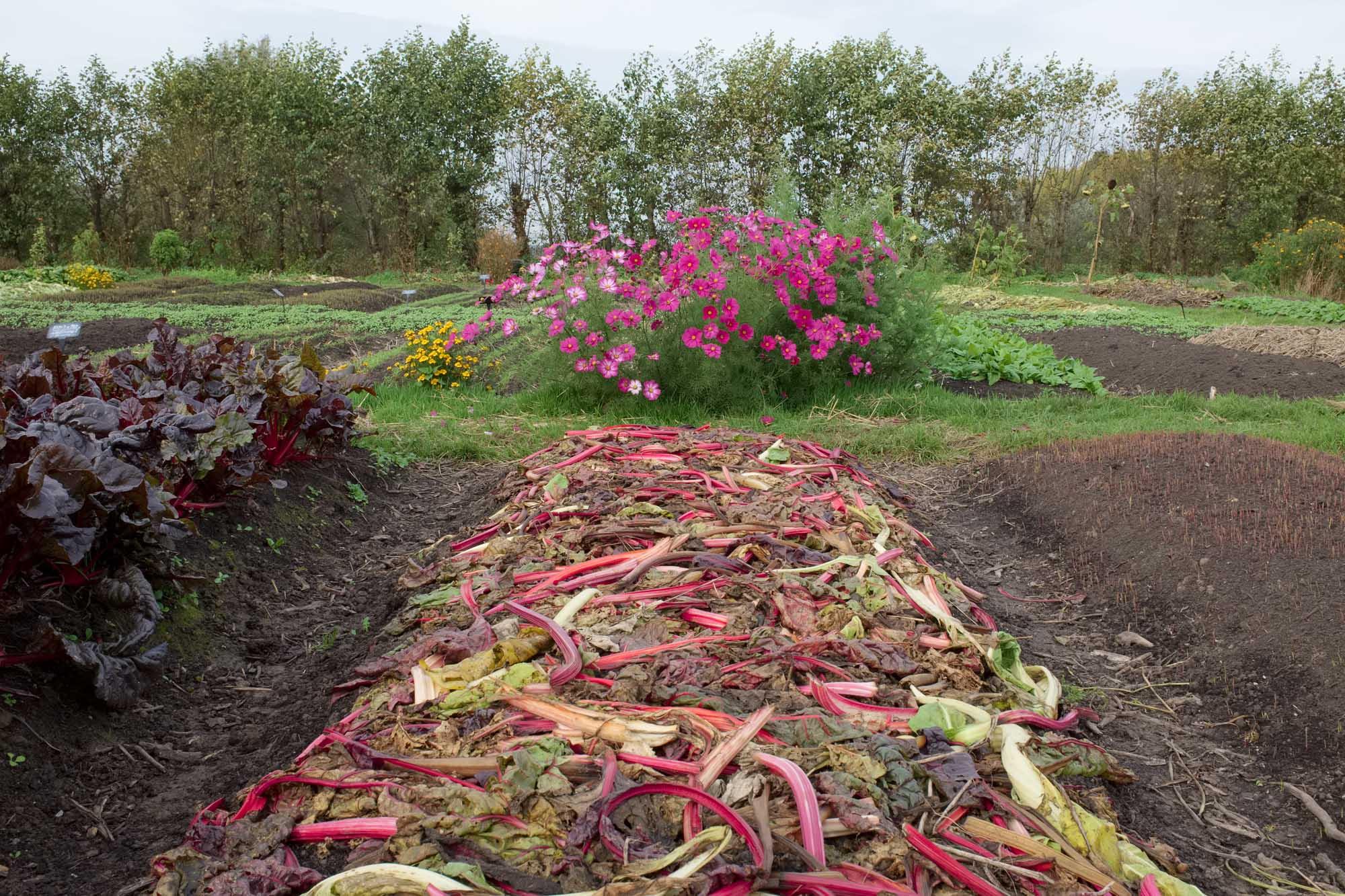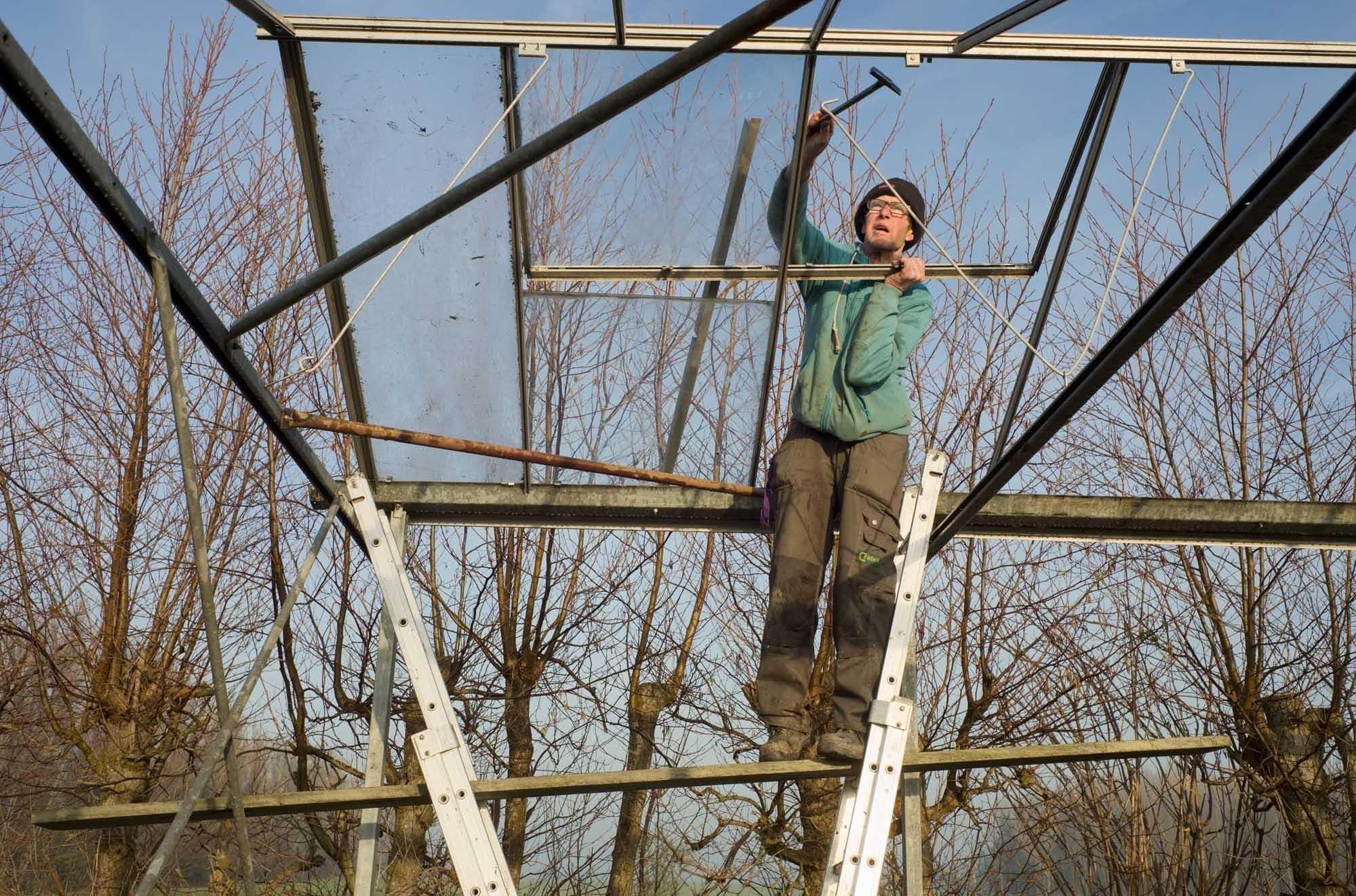by Ellen Kok
'Agriculture in general is the single most destructive force on this planet and continues to be so for the foreseeable future, unless people start to figure it out,' opines farmer Bruce Bickford, while harvesting green beans one by one during a warm, late September morning, on his organic Abenaki Springs Farm in the state of New Hampshire in the U.S.
'It's breaking the ground and destroying all the micro-organisms, with the chemicals and the run-offs and the fertilizers", he continues. "They always say there's not enough land, but if you do organic, you are building soil and your production goes up over time, versus all the big farms, where it is: more chemicals, production going down.'
For Farming for the Neighbors, during four seasons I document life on two small American family farms in the rural west of New Hampshire: Abenaki Springs Farm and Hillside Springs Farm. I also follow the start-up of a new community vegetable garden in the Netherlands, run by four women: the Proeftuin van Linschoten (which translates as the Taste Garden), situated in the village of Linschoten.
All three farms try to grow food in a sustainable way and sell their vegetables, fruit and meat exclusively to local customers through farmers markets, farm stands and especially Community Supported Agriculture (CSA) subscriptions.
CSA members purchase a harvest share of farm products up front, which allows farmers to pay for seed, tools and utilities prior to market season, and start up production. Rather than being connected anonymously through wholesalers and supermarkets, farmers and members share the risks involved in the nature of agriculture: drought, disease, unpredictable weather, early frosts, rodents, crop failure. They also share the joy of good, nutritious, tasty crops. CSA members know where their veggies and meat come from and how they were produced, and they pay their farmers a fair price for it.
Food production with the help of chemical fertilizers, pesticides and antibiotics may at first give a higher yield, but in the long run these intensive farming methods deplete the farmland, and cause bacteria to develop resistance against antibiotics. It is not true that industrial, highly subsidized agriculture feeds the world: 35 percent of food world-wide is produced by small local farmers with a close, personal connection to the land they work on, the animals they work with, and the community they feed. The problem is that their sustainable ways of growing are undercut by Big Ag with its lower prices.
With this ongoing project I want to raise awareness of the importance of local, climate-smart agriculture and share the stories of farmers who make it their business to grow healthy food for their neighbors.
Farming for the Neighbors is part of a global project on Community Supported Agriculture of the international photographers group terrafoto .
Part 1
BUILD SOIL
Abenaki Springs Farm, which is run by Bruce Bickford and Kirsten Anderson in Walpole, New Hampshire, sits on a rich plain, located above the old Abenaki Springs, which was once a sacred water supply to the Abenaki Tribe, that lived here before the settlers came. These "People of the Dawn Land" supplemented agriculture with hunting and gathering.
Farmers Bruce and Kirsten grow five acres of certified organic vegetables and berries, and also raise pastured turkeys, chickens, and pigs. They believe 'soil health is the key to nutrient density' and that's why they utilize growing practices — composting, crop rotation, cover crops and seasonal diversity — that are designed to increase organic matter and biological activity. 'It is our goal to regenerate the land for future generations while providing optimal nutrient rich food.'
You can find this story on the terrafoto website.
'Agriculture in general is the single most destructive force on this planet and continues to be so for the foreseeable future, unless people start to figure it out,' opines farmer Bruce Bickford, while harvesting green beans one by one during a warm, late September morning, on his organic Abenaki Springs Farm in the state of New Hampshire in the U.S.
'It's breaking the ground and destroying all the micro-organisms, with the chemicals and the run-offs and the fertilizers", he continues. "They always say there's not enough land, but if you do organic, you are building soil and your production goes up over time, versus all the big farms, where it is: more chemicals, production going down.'
For Farming for the Neighbors, during four seasons I document life on two small American family farms in the rural west of New Hampshire: Abenaki Springs Farm and Hillside Springs Farm. I also follow the start-up of a new community vegetable garden in the Netherlands, run by four women: the Proeftuin van Linschoten (which translates as the Taste Garden), situated in the village of Linschoten.
All three farms try to grow food in a sustainable way and sell their vegetables, fruit and meat exclusively to local customers through farmers markets, farm stands and especially Community Supported Agriculture (CSA) subscriptions.
CSA members purchase a harvest share of farm products up front, which allows farmers to pay for seed, tools and utilities prior to market season, and start up production. Rather than being connected anonymously through wholesalers and supermarkets, farmers and members share the risks involved in the nature of agriculture: drought, disease, unpredictable weather, early frosts, rodents, crop failure. They also share the joy of good, nutritious, tasty crops. CSA members know where their veggies and meat come from and how they were produced, and they pay their farmers a fair price for it.
Food production with the help of chemical fertilizers, pesticides and antibiotics may at first give a higher yield, but in the long run these intensive farming methods deplete the farmland, and cause bacteria to develop resistance against antibiotics. It is not true that industrial, highly subsidized agriculture feeds the world: 35 percent of food world-wide is produced by small local farmers with a close, personal connection to the land they work on, the animals they work with, and the community they feed. The problem is that their sustainable ways of growing are undercut by Big Ag with its lower prices.
With this ongoing project I want to raise awareness of the importance of local, climate-smart agriculture and share the stories of farmers who make it their business to grow healthy food for their neighbors.
Farming for the Neighbors is part of a global project on Community Supported Agriculture of the international photographers group terrafoto .
Part 1
BUILD SOIL
Abenaki Springs Farm, which is run by Bruce Bickford and Kirsten Anderson in Walpole, New Hampshire, sits on a rich plain, located above the old Abenaki Springs, which was once a sacred water supply to the Abenaki Tribe, that lived here before the settlers came. These "People of the Dawn Land" supplemented agriculture with hunting and gathering.
Farmers Bruce and Kirsten grow five acres of certified organic vegetables and berries, and also raise pastured turkeys, chickens, and pigs. They believe 'soil health is the key to nutrient density' and that's why they utilize growing practices — composting, crop rotation, cover crops and seasonal diversity — that are designed to increase organic matter and biological activity. 'It is our goal to regenerate the land for future generations while providing optimal nutrient rich food.'
You can find this story on the terrafoto website.
Abenaki Springs Farm after a rainy day.
Walpole, New Hampshire, USA. July 2022
Walpole, New Hampshire, USA. July 2022
Early morning at sunrise. Farmer Bruce Bickford explains to farmworker Robin Bigaj where to weed and mulch straw around tomato plants, which will prevent weeds from growing back and moisture from evaporating, and make a smooth bed for the tomatoes. On the pickup truck teenager Faith is waiting. She will be picking blueberries, her summer job.
Walpole, New Hampshire, USA. July 2022.
Walpole, New Hampshire, USA. July 2022.
Farmer Kirsten Anderson weighs and packs lettuce, while carrying her almost one year old son Emmett.
Walpole, New Hampshire, USA. September 2021.
Walpole, New Hampshire, USA. September 2021.
Bruce sets up his produce stand for the Saturday Farmers Market in Keene, New Hampshire, a half hour drive from the farm. His wife Kirsten sells their products on the same day on the market in Londonderry in neighboring state Vermont, an hour away. The markets are their biggest source of income, fifty percent of their total sales. They both take pride and joy in building up a nice veggies and fruits display, which also boosts sales.
Bruce says: “If our prices are in line with the stores, the best deal people are getting for their dollar for nutrition would be at a farmers market. You can’t get it any fresher. For years, before we had the cooler, I literally harvested all night before I went to market and people would come and I could say: ‘Yeah, this was picked at three o’clock this morning’. It was five hours from harvest when they got it. You can’t get that unless you have your own garden. But it’s hard for people to get that mentality, it’s all about convenience. They want that easy salad.”
New Hampshire, USA. October 2021.
Bruce says: “If our prices are in line with the stores, the best deal people are getting for their dollar for nutrition would be at a farmers market. You can’t get it any fresher. For years, before we had the cooler, I literally harvested all night before I went to market and people would come and I could say: ‘Yeah, this was picked at three o’clock this morning’. It was five hours from harvest when they got it. You can’t get that unless you have your own garden. But it’s hard for people to get that mentality, it’s all about convenience. They want that easy salad.”
New Hampshire, USA. October 2021.
Broiler chickens kept on pasture find shade under an old pickup truck roof. Abenaki Springs Farm offers its customers a CSA subscription of pasture raised poultry and pork. Farmer Bruce raises the birds from chicks: “They get shipped here through the mail the day they are hatched and usually arrive by the next day.”
The little, yellow fluff balls are sent in cardboard boxes with vent-holes from Cincinnati, Ohio. Bruce: “I try to keep them on pasture as soon as I can. And I start them on organic grain and kelp from day one.” Kelp is a seaweed that is rich in iodine, vitamines and minerals. The manure that the chickens spread improves the soil.
Walpole, New Hampshire, USA. June 2022.
The little, yellow fluff balls are sent in cardboard boxes with vent-holes from Cincinnati, Ohio. Bruce: “I try to keep them on pasture as soon as I can. And I start them on organic grain and kelp from day one.” Kelp is a seaweed that is rich in iodine, vitamines and minerals. The manure that the chickens spread improves the soil.
Walpole, New Hampshire, USA. June 2022.
Sarah (17), daughter of Bruce, waters spinach. She’s wearing one of her father's old T-shirts.
Walpole, New Hampshire, USA. May 2022.
Walpole, New Hampshire, USA. May 2022.
Part 2
By Horse and by Hand
Hillside Springs Farm in Westmoreland, New Hampshire, is the small, draft horse powered CSA farm of Kim Peavey and Frank Hunter. On three acres they grow over 100 varieties of vegetables, berries, herbs, flowers, and mushrooms. The farm also produces freshly pressed apple cider. They only use sustainable, organic, and biodynamic farming methods, though the farm is not certified.
Every week during harvest season, early June to late November, 50 local families pick up their vegetables and fruits on the farm or at the farmers market in the nearby town of Keene. Kim and Frank like to be transparent about their way of farming: 'The ongoing relationship between farmers, CSA members, and the farmland allows us all to understand what's happening on the farm without a third-party certification process. Members have the opportunity to observe, ask questions, and even pitch in!’
You can find this story on the terrafoto website.
By Horse and by Hand
Hillside Springs Farm in Westmoreland, New Hampshire, is the small, draft horse powered CSA farm of Kim Peavey and Frank Hunter. On three acres they grow over 100 varieties of vegetables, berries, herbs, flowers, and mushrooms. The farm also produces freshly pressed apple cider. They only use sustainable, organic, and biodynamic farming methods, though the farm is not certified.
Every week during harvest season, early June to late November, 50 local families pick up their vegetables and fruits on the farm or at the farmers market in the nearby town of Keene. Kim and Frank like to be transparent about their way of farming: 'The ongoing relationship between farmers, CSA members, and the farmland allows us all to understand what's happening on the farm without a third-party certification process. Members have the opportunity to observe, ask questions, and even pitch in!’
You can find this story on the terrafoto website.
Farmers Frank Hunter and Kim Peavey putting up hay on Hillside Springs Farm.
Westmoreland, New Hampshire, USA. September 2021.
Westmoreland, New Hampshire, USA. September 2021.
Farmer Frank harvests kale.
Westmoreland, New Hampshire, USA. September 2021.
Westmoreland, New Hampshire, USA. September 2021.
Every year a group of students of Kroka Wilderness Expedition School from Marlow, New Hampshire, and their two instructors camp two nights in the woods on Hillside Springs Farm and help with chores.
Westmoreland, New Hampshire, USA. September 2022.
Westmoreland, New Hampshire, USA. September 2022.
Cherry tomatoes ripen in one of the greenhouses of Hillside Springs Farm.
Westmoreland, New Hampshire, USA. June 2022.
Westmoreland, New Hampshire, USA. June 2022.
Marjorie, who lives in the nearby town of Keene, picks flowers on Hillside Springs Farm. This is her fourth year as a CSA subscriber. One of her reasons for joining is that she can visit and enjoy the farm.
Westmoreland, New Hampshire, USA. September 2021.
Westmoreland, New Hampshire, USA. September 2021.
Kim and Frank make fresh apple cider. Kim washes the apples, after which Frank squeezes out the juice in a hand press. The apple pomace that is left goes onto the compost heap.
Westmoreland, New Hampshire, USA. September 2021.
Westmoreland, New Hampshire, USA. September 2021.
Part 3
PROEFTUIN VAN LINSCHOTEN, an ECOLOGICAL MARKET GARDEN
Proeftuin van (Taste Garden of) Linschoten is a new market garden in the village of Linschoten in the Netherlands. It is run by four women: initiator Natascha Boel and gardeners Matty Vink, Emma Smeets, and Jantien Meijer, with the help of many community volunteers. Together they are transforming an old, four acre pear orchard into a nature-inclusive vegetable, herbs and fruit garden. The project is in its second year and is subsidized by the European Fund for Rural Development and the Dutch province of Utrecht.
The garden is situated on the bank of a small river on Landgoed Linschoten, a private estate consisting of a mansion, surrounded by woods and pastures. 2022 was a pilot year, to see if the soil, a very dense river clay, would be suitable for growing vegetables. It was a big succes: the garden exploded with veggies and flowers, which attracted many pollinating insects.
Winter and spring of 2023 brought a flurry of building activity of a different sort. For months the garden looked more like a muddy battlefield than a sunny paradise: irrigation and power lines were installed in trenches, pear trees were uprooted and replanted to make way for two glasshouses and two tiny eco-lodges. Nesting-boxes were mounted in the hedgerow for 26 different bird species.
Finally, the gardeners were able to sow and plant and sell their first CSA shares. The shareholders are encouraged to self-harvest. They receive a weekly harvest email with online links to Youtube clips in which gardeners Matty and Emma explain how to cut spinach so it will grow back for a second cutting, or how to detach a head of lettuce from its roots by carefully turning it around. In four years they hope Proeftuin van Linschoten will be a viable business, so that it can continue reconnecting people, nature and agriculture.
This story has not been completed yet.
PROEFTUIN VAN LINSCHOTEN, an ECOLOGICAL MARKET GARDEN
Proeftuin van (Taste Garden of) Linschoten is a new market garden in the village of Linschoten in the Netherlands. It is run by four women: initiator Natascha Boel and gardeners Matty Vink, Emma Smeets, and Jantien Meijer, with the help of many community volunteers. Together they are transforming an old, four acre pear orchard into a nature-inclusive vegetable, herbs and fruit garden. The project is in its second year and is subsidized by the European Fund for Rural Development and the Dutch province of Utrecht.
The garden is situated on the bank of a small river on Landgoed Linschoten, a private estate consisting of a mansion, surrounded by woods and pastures. 2022 was a pilot year, to see if the soil, a very dense river clay, would be suitable for growing vegetables. It was a big succes: the garden exploded with veggies and flowers, which attracted many pollinating insects.
Winter and spring of 2023 brought a flurry of building activity of a different sort. For months the garden looked more like a muddy battlefield than a sunny paradise: irrigation and power lines were installed in trenches, pear trees were uprooted and replanted to make way for two glasshouses and two tiny eco-lodges. Nesting-boxes were mounted in the hedgerow for 26 different bird species.
Finally, the gardeners were able to sow and plant and sell their first CSA shares. The shareholders are encouraged to self-harvest. They receive a weekly harvest email with online links to Youtube clips in which gardeners Matty and Emma explain how to cut spinach so it will grow back for a second cutting, or how to detach a head of lettuce from its roots by carefully turning it around. In four years they hope Proeftuin van Linschoten will be a viable business, so that it can continue reconnecting people, nature and agriculture.
This story has not been completed yet.
Hampshire Down sheep graze in the section of the old pear orchard of Proeftuin van Linschoten that hasn’t been cleared of fruit trees. The pears will be harvested in the fall and juice will be pressed from them.
Linschoten, The Netherlands. August 2022.
Linschoten, The Netherlands. August 2022.
Gennaro Scognamiglio (right), ecological gardener and botanical artist, designed the garden landscape for the Proeftuin of Linschoten, which is still used as its basis. He left as its master gardener in the fall of 2022 to pursue new projects. Here he shows volunteers Nina Linders (left) and Matty Vink (who would later succeed him as a gardener), how to string freshly harvested onions with rope to hang them up for drying.
Linschoten, The Netherlands. August 2022.
Linschoten, The Netherlands. August 2022.
Andrea, who has just started as a volunteer at Proeftuin van Linschoten, picks yellow string beans. At this Dutch ecological market garden only seasonal vegetables and fruits are grown.
Linschoten, The Netherlands. August 2022.
Linschoten, The Netherlands. August 2022.
To protect the soil against dehydration, frost and erosion, by the end of autumn, some already bare planting beds were covered with mulch and leftover plant parts. In other beds (right) green manure cover crops like winter rye and mustard, which enrich the soil with nitrogen and improve its structure, were sown.
Linschoten, The Netherlands. November 2022.
Linschoten, The Netherlands. November 2022.
Gardener Emma Smeets installs a water supply system for sprinkler and porous-hose irrigation.
Linschoten, The Netherlands. March 2023.
Linschoten, The Netherlands. March 2023.
Mr. Hendriks, 85, builds a glasshouse in the vegetable garden.
Linschoten, The Netherlands. February 2023.
Linschoten, The Netherlands. February 2023.
Farming for the Neighbors

Ellen Kok
Photographer and Writer
based in New Hampshire, USA

